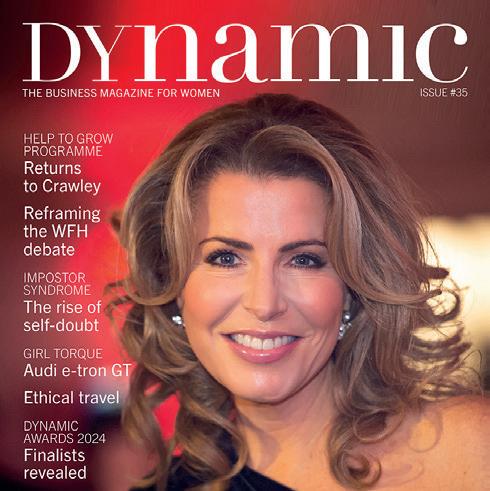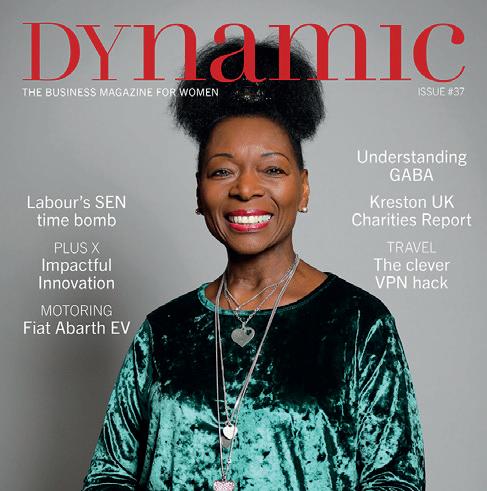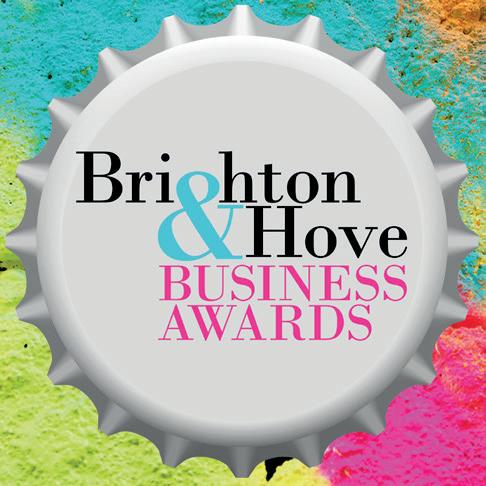
TRAVEL
The Ikarian Way

Boosting happiness at work
The talent pipeline

The Harman Report
GIRL TORQUE
On the electric fence

WINE & DINE
Starling Bistro


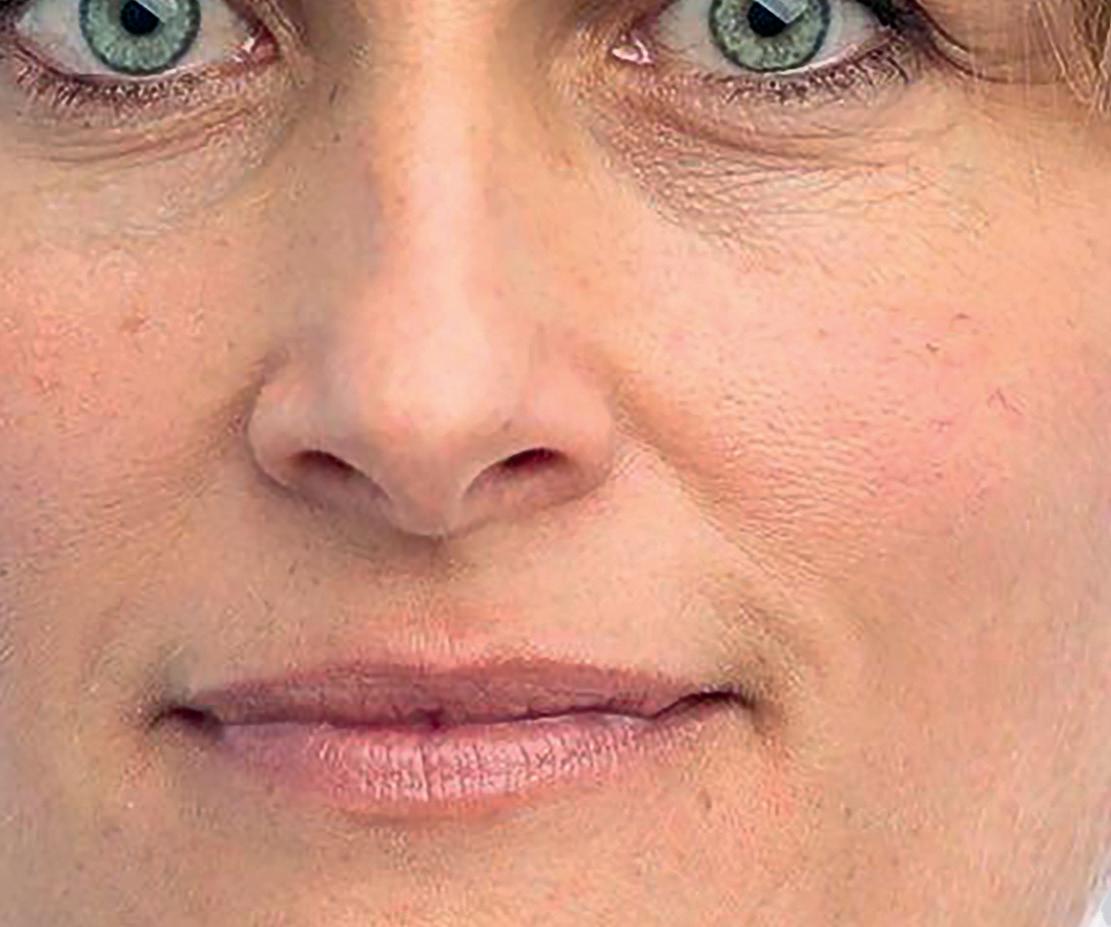

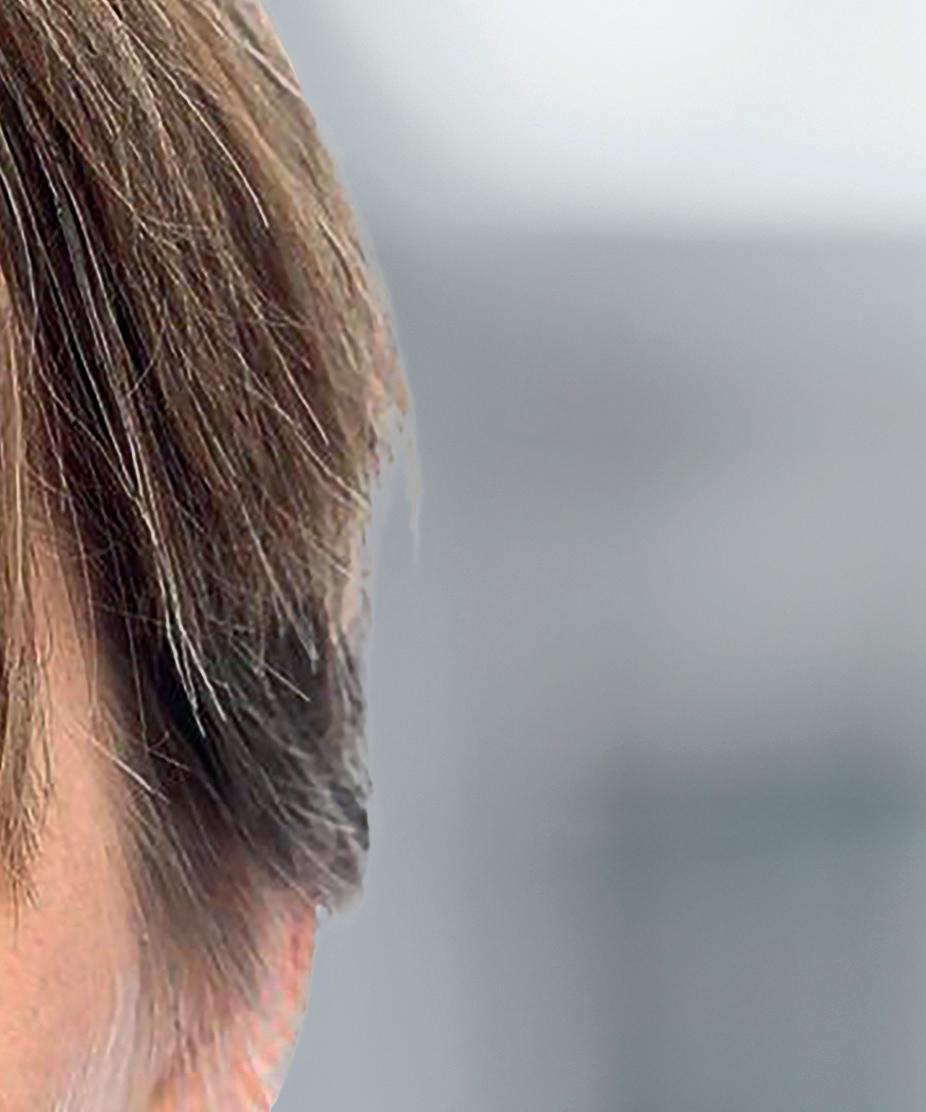
Alex Bailey Being flexible Pippa Moyle Judging at the BAHBAs
THE BIG STORY





The Ikarian Way

Boosting happiness at work
The talent pipeline

The Harman Report
GIRL TORQUE
On the electric fence

WINE & DINE
Starling Bistro





Alex Bailey Being flexible Pippa Moyle Judging at the BAHBAs
THE BIG STORY



FIRST FEMALE HEAD OF MI6














News
4 Upfront: The top international news stories involving women in business
8 In the Right Direction: Good news stories from around the world
Regulars
6 The Alex Bailey Column
A flexible approach to leadership brings its own rewards
10 The City Girl Column
What Pippa Moyle learned from judging at the BAHBAs
12 The Laura Hearn Column Excellence isn’t a destination, it’s an everyday practice
14 The Natalie Montagnani Column
Introducing the founder of Ignite, who suggests that if women want a seat at the table, they bring their own chair
Events
20 Dynamic Awards 2026
Back for their fifth year, the premier awards for women in busines is open for entries
The first female Chief of MI6 (or SIS to give it its proper title) took to her new role this month. Dynamic looks at the parts of her career which are known to the public, and how she follows a recent trend of women being offered the top jobs in intelligence
31 Future Female Leaders
i360 owner Sarah Willingham will be sharing the secrets of her business journey. A Dynamic & Help to Grow event
Features
16 Don’t say it isn’t personal
Tess de Klerk reminds us of a few truths over the toxic narrative surrounding immigration in the UK
28 Happiness at work
Mary Taylor offers some techniques for boosting satisfaction at work
30 Spotlight
Focusing on Kate Lester, CEO of Diamond Logistics
32 The Harman Report Baroness Harman KC has delivered a report on bullying, harrassment and sexual misconduct at the Bar
34 The talent pipeline Employers cannot afford to ignore the ‘confidence challenge’
Wellbeing
36 Menstrual migraines
Suggested methods of dealing with this potentialy disruptive issue
What you do makes a difference, and you have to decide what kind of difference you want to make.”
– Dame Jane Goodall
38 Creatine Is it OK to be taking this supplement?
Art
40 Art ‘What Lies Beneath’ – Kellie Miller on the works of Helen Nottage
Further Reading
42 Self-publishing
Is self-publishing a viable option for unknown authors?
Travel
44 The Ikarian Way
Tess de Klerk discovers Ikaria – the Greek island with a much slower, simpler way of life
Wine & Dine
48 The Michelin-starred Starling Bistro in Esher, Surrey
Girl Torque
50 Sitting on the electric fence
Fiona Shafer, MD at MDHUB, asks if we need to go back for our future to be sustainable
What’s On
52 A brief snapshot of what’s on in Sussex and Surrey
Welcome to another jam-packed edition of Dynamic.
We are so very proud to feature contributions from interesting and talented women who share their wisdom and lived experience with you, our readers. As Laura Hearn’s column title this month says: ‘Excellence isn’t a destination, it’s an everyday practice’.
This is evident in the work and determination shown not only in our contributors’ daily lives but also by all the brave entrants of Platinum’s awards, as pointed out by Pippa Moyle this month.
Our Big Story digs into the life and career of Blaise Metreweli, MI6’s first female Chief. I can only imagine the hard work and bravery it took to get to where she is today!
Our new columnist, Natalie Montagnani advises on how to move forward as a woman in what is, at times, still ‘a man’s world’ while we explore the importance of investing in the confidence of the talent pipeline.
Read about the very zen Blue Zone island of Ikaria in Travel while Further Reading looks a little different this month - we ask if self-publishing is a viable option for unpublished authors.
And so much more. We hope that you enjoy what we have curated for you this October.
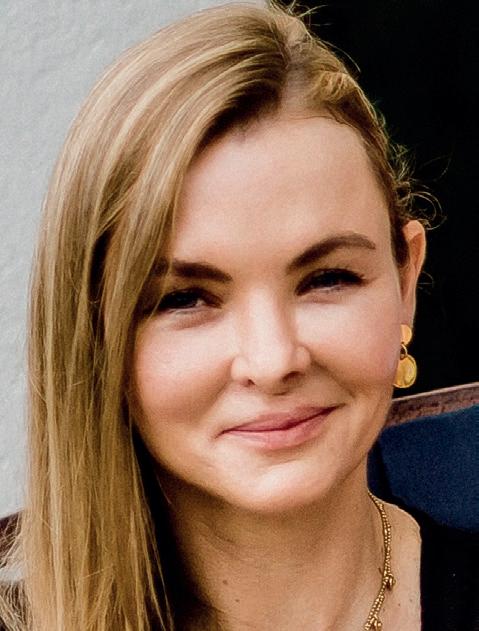
Editor, Dynamic Magazine tess@platinummediagroup.co.uk
PUBLISHER: Maarten Hoffmann maarten@platinummediagroup.co.uk
EDITOR: Tess de Klerk tess@platinummediagroup.co.uk
MOTORING EDITOR: Fiona Shafer fionaas@platinummediagroup.co.uk
COMMERCIAL DIRECTOR: Lesley Alcock lesley@platinummediagroup.co.uk
EVENTS DIRECTOR: Fiona Graves fiona@platinummediagroup.co.uk
HEAD OF DESIGN / SUB EDITOR: Alan Wares alan@platinummediagroup.co.uk
A female Chinese national in the UK has been convicted following an international fraud investigation which resulted in what’s believed to be the single largest cryptocurrency seizure in the world. The Metropolitan Police says it recovered 61,000 bitcoin worth more than £5bn in current prices.
Zhimin Qian, also known as Yadi Zhang, pleaded guilty on September 29th at Southwark Crown Court of illegally acquiring and possessing the cryptocurrency. Between 2014 and 2017, she led a large-scale scam in China, which involved cheating more than 128,000 victims and storing the stolen funds in bitcoin assets. It said the 47-year-old’s guilty plea followed a seven-year probe into a global money laundering web which began when it got a tip-off about the transfer of criminal assets.
Britain’s second-biggest drugmaker GSK has announced the departure of its chief executive, Dame Emma Walmsley, after eight years in the top job. Walmsley, 56, who has run the FTSE 100 company since 2017, will
The amount of money earned by the victorious England Rugby World Cup-winning team (The Red Roses) has come in for criticism as contract figures were released during the recent tournament. There are five tiers of women’s rugby contracts, with the highest being worth £49,600 per year. The players in the squad received £5,000 just for playing in the World Cup, while the entire team was awarded another £20,000 for being the outright winners.
This is in stark comparison to the France men’s team from their tournament two years ago, who would have received €200,000 (£174,000) each had they won.
step down from the board at the end of this year, and remain at GSK until her notice period ends on September 30th 2026. It is unclear what she will do then, but she said she had no intention of retiring. Luke Miels, GSK’s chief
commercial officer, whom she brought in from rival AstraZeneca in 2017 and described as a “dream appointment” in her diary, will replace her and start on January 1st.
Kerrie Herbert has been awarded almost £30,000 in compensation and legal costs after an employment tribunal found she had been unfairly dismissed.
The ruling came in the case of an office manager who was sacked on the spot when – during a row – she called her manager and another director dickheads. The employment judge Sonia Boyes ruled that the scaffolding and brickwork company she worked for had not “acted reasonably in all the circumstances in treating [her] conduct as a sufficient reason to dismiss her.
“She made a one-off comment to her line manager about him and a director of the business,” Boyes said. “The comment was made during a heated meeting.
The government has won its legal claim against a company linked to the peer Michelle Mone for the return of millions of pounds paid for personal protective equipment during the Covid pandemic.
The Department of Health and Social Care sued the company, PPE Medpro, in December 2022, arguing that it had not complied with PPE laws to ensure that 25m surgical gowns it provided under a June 2020 government contract were sterile. The trial heard that the gowns, for which the DHSC paid £122m, were rejected after their first UK inspection in September
2020 and never used in the NHS. The gowns, manufactured in China, were labelled with a CE mark, denoting compliance with European standards, but no authorised quality assurance organisation had certified their safety and sterility.
PPE Medpro is owned by Mone’s husband, the Isle of Man-based businessman Doug Barrowman. The judge, Mrs Justice Cockerill, who heard the five-week trial at London’s Rolls Building in the summer, ruled in favour of the DHSC and ordered PPE Medpro to repay the full £122m plus additional costs and interest.
World leaders, business executives, activists, scientists, and policy makers gathered in New York City at the end of September for Climate Week, the largest global climate event of its kind. More than 500 events amplified the scale of the climate crisis and the opportunity for climate action.
Women, the event agreed, often bear the brunt of climate change’s effects.
Women are more likely than men to live in poverty and rely on natural resources for their livelihoods, leaving them disproportionately vulnerable to floods, droughts, and displacement. According to the United Nations’ Gender Snapshot 2025 report, climate change may push up to 158 million more women and girls into poverty by 2050, which is 16 million more than the total number of men and boys.
Charlie Javice, the entrepreneur convicted for defrauding JPMorgan Chase into buying her college financial aid startup Frank for $175m, has been sentenced to just over seven years in prison.
Javice, 33, was convicted in March on all four counts she faced: bank fraud, securities fraud, wire fraud and conspiracy. She had pleaded not guilty and is expected to appeal her conviction. Prosecutors with the Manhattan U.S. Attorney’s office had sought a 12-year prison sentence.
Javice founded Frank in 2017, and won praise for simplifying college financial aid for students and parents. She became a rising star in finance and appeared on Forbes magazine’s “30 Under 30” list in 2019.
Retired women in the UK, in effect, go four months of the year without a pension when their income is compared with that of men, union leaders have warned.
The TUC said the income gap between men and women in retirement was 36.5%, equivalent to a shortfall of £7,600 a year on average. As a percentage, this was more than double the gender pay gap, which measures the difference in average earnings from work, currently standing at 13.1%.
The union organisation stated that this meant retired women effectively stopped receiving a pension from August 21st, compared to men, creating a four-month gap.
“The beauty of being a feminist is that you get to be whatever you want. And that’s the point.”
- Shonda Rhimes
❛ ❛
“Don’t be afraid to speak up for yourself. Keep fighting for your dreams!”
– Gabby Douglas
Two Horsham women have set up a new company to help business leaders with confidence.
Suzie Yates, along with co-founder Libby Crossland, has started The Leadership Visibility Co. The new company helps CEOs, founders, and C-suite leaders show up with confidence and proof, so the right people recognise their value, and visibility becomes a pipeline for partnerships and progress.
Suzie previously led multi-million-pound commercial remits, launched profitable national magazines, and serves on an industry board, leveraging her marketing and commercial skills. Libby built and scaled executive-branding teams, served as Head of Marketing for a £45m recruitment group and held VP roles in a global learning and development scale-up.
The UK’s first female Chancellor, Rachel Reeves, is set to lift the two-child benefit limit in the budget, a key demand of her own party’s MPs and child poverty campaigners, with officials exploring the option of a tapered system instead.
The chancellor has said she expects to respond to recommendations of the child poverty taskforce at the budget, which is expected to say that lifting the two-child limit for universal credit and child tax credit would be one of the most effective ways to lift hundreds of thousands of children out of poverty.
Neither Sir Keir Starmer nor Reeves confirmed that they would scrap the cap in their speeches at the Labour party conference, but they have been emphatic about the need to address child poverty.

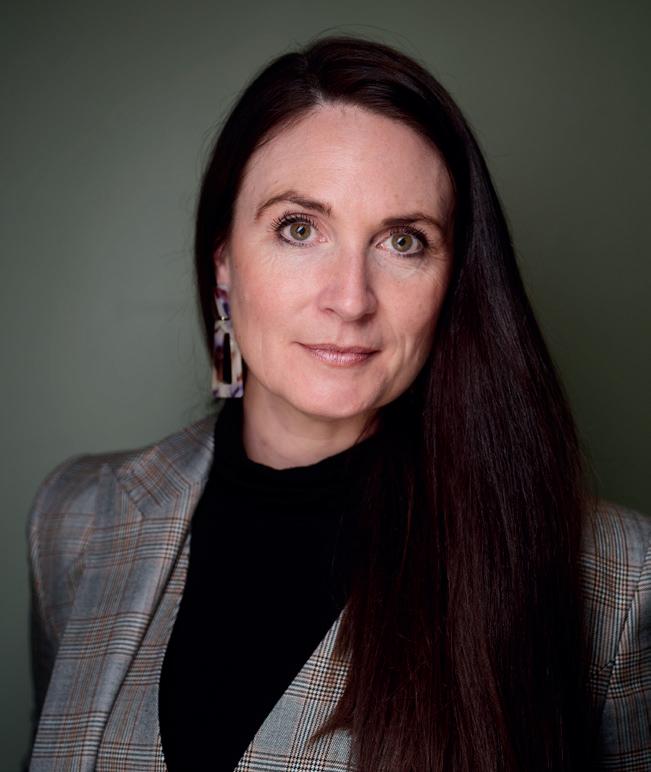





We are delighted to have Co-Founder, with 20+ years organisational change. delivering impactful programmes






’ve often felt I’m great at flexing to my context and adapting to new challenges, but if I’m honest with myself, I am great at being flexible and adapting to anything, if it’s something I want to do. Recently, I’ve been exploring what more is required of me as a leader in this changing world and what I can learn to apply to my business and my work.






Our world is now defined by uncertainty and complexity, and, as a result, flexibility in leaders has rapidly become one of the most valuable human skills required. It is critical for all organisations navigating constant change on multiple levels.





Psychological flexibility is the ability to remain present, adapt to a shift in circumstances and take purposeful action that is aligned with personal values, even in the face of discomfort. It’s more than just being mentally fit, tough or resilient; it’s about being a leader who can hold multiple perspectives, regulate emotions and respond rather than react.

To develop greater flex, we need to focus on building skills in five core areas:

• Accepting emotions without trying to avoid or fi x them


• Distancing ourselves and taking a step back for perspective to look at what’s true
• Remaining present rather than reliving the past or worrying about the future
By Alex Bailey






“Psychological flexibility is the ability to remain present, adapt to a shift in circumstances and take purposeful action”





have Alex Bailey contributing to Dynamic. She is a Global CEO and years of expertise in HR leadership, psychology, coaching, and She specialises in cultural evolution, leadership,and performance, programmes globally while speaking at international events.
• Anchoring in our values, where we know what matters to us and balance it with organisational needs

• And taking action with small positive steps, even when stepping into the unknown.






I often hear that leaders are constantly fi refighting, and I’ve certainly experienced significant challenges in my leadership journey, owning my own business over the years, but the increased pace of change, along with the increased number of major changes we are experiencing at once, has left leaders feeling frazzled.











“Being more fl exible in our thinking enhances decisionmaking under pressure”
vocabulary for a long time and is nothing new. However, much of what helps me and other leaders improve is about bringing our subconscious to the forefront of our attention, intentionally recognising when we can use particular skills and then taking the steps to deploy them in the moment, at pace. And it’s the pace here that matters; the rapid acceptance of new scenarios, shifts in outcomes and expectations that really create agility in leaders, teams and organisations.
The great aspect of this is that it is trainable.
Building greater flexibility is a key prevention of burnout, particularly when leaders suppress their emotions to appear strong to others. By acknowledging how we feel when a challenge or change occurs, we are able to listen to what this emotion is indicating to us, and this can help us use our experience to respond appropriately in the moment. Leaders who have greater flexibility experience lower stress and greater

Being more flexible in our thinking enhances decision-making under pressure, where leaders are more able to pause, reflect, and choose actions that serve longer-term goals.
Flexibility helps us create safety and trust in our teams by role-modelling agility and openness, which means people feel safer to speak up, take risks and learn from mistakes. Th is trust and safety is also critical for a culture of innova-


Th is approach helps us anchor to what matters most to us amid the chaos by reflecting on our values, which are deeply rooted in life experiences, and can help guide us if we align them to the organisational needs.

Businesses of all sizes need to remain adaptable in their strategies to innovate continuously. Flexible leaders are better able to pivot at pace, reframe setbacks, and experiment with new opportunities.

When focusing on developing this skill for myself, I felt like so much of it referred to techniques I recognised and felt familiar with. After all, “flexibility” has been in our tion and growth.

We can work on developing our flexibility in many ways, including:
1. Asking what our emotions are telling us about any given situation. The more we practice this continually, the more likely we are able to tap into our intuition when most required.
2. Stepping back when a challenge occurs and reflecting on whether our thoughts about the situation are indeed factual, or a narrative we are carrying from something else.

3. Focusing on what’s within our control right now to remain present.
4. Reflecting on what is most important to you in your role, ask, “What truly matters to me as a leader?” Use this as a compass during difficult decisions.
5. Breaking challenges into the smallest next step, then taking it.
Developing psychological flexibility isn’t just important for us as leaders, it creates a culture that develops intergenerational respect and bridges cultural divides by supporting open conversations where everyone feels seen, heard and valued.

Alex Bailey styled by Gresham Blake Email: Alex@baileyandfrench.com www.baileyandfrench.com Insta @alexbaileybackstage Follow me on LinkedIn: www.linkedin.com/in/ alex-bailey-26562b2/


“You are allowed to be both a masterpiece and a work in progress simultaneously.”
- Sohpia Bush
A major Dutch pension scheme for health and welfare workers will withdraw €14.5bn from BlackRock due to its fossil fuel investments. The fund, PFZW, announced the move after BlackRock left the Net Zero Asset Managers Alliance, a group pushing for carbon neutrality. Campaigners from Go Fossil Free

called it a victory that reduced BlackRock’s influence and directed money toward greener alternatives. They urged other pension funds, including ABP, the Netherlands’ largest, to follow suit. The withdrawal is seen as a significant win for climate-focused financial activism in Europe. about distraction, arguing that banning phones





A study involving nearly 17,000 Indian students has shown that banning smartphones in classrooms leads to higher grades. Pupils in phone-free lessons performed better, particularly those who were struggling academically. The research, led by the University of Pennsylvania, aligns with findings from the Netherlands, where most schools reported improved concentration after bans. UK campaigners welcomed the results. Daisy Greenwell from Smartphone Free Childhood said the study confirmed long-held concerns about distraction, arguing that banning phones is a simple, low-cost way to enhance learning outcomes and benefit disadvantaged children most.




















Scientists in England have developed a quicker MRI scan for prostate cancer diagnosis, which could benefit millions of men. Traditional scans use three steps and require dye injection, making them slow and expensive. Researchers at University College London and the University of Birmingham found a two-step scan without dye was just as accurate and far quicker. Only 62% of eligible men currently receive an MRI, but the new method could change that. A second UK trial is underway, aiming to confirm evidence and reshape clinical practice nationwide.


An AI tool that analyses brain scans has sped up stroke diagnosis across the NHS, leading to faster treatment and better recovery rates. The system has already been used on more than 60,000 scans and is credited with helping over half of patients regain function. Doctors can make quicker treatment decisions, crucial since stroke patients lose millions of brain cells each minute. NHS England said the rollout marks a revolution in care. Experts called it a powerful example of how technology can transform outcomes in emergency medicine.
“Remember no one can make you feel inferior without your consent.”
- Eleanor Roosevelt
The United States is on course to retire more coal capacity in 2025 than it did last year, according to Carbon Brief. The report noted that while the US steps back from coal, other countries such as Vietnam, Indonesia and South Africa are also reducing use. For the first time, no new coal plants

Renewable energy companies are making progress on human rights despite policy pressures, according to a study by the Business and Human Rights Resource Centre. The report examined 35 firms and found that many were embedding rights commitments into operations. Campaigners
said a fair transition to clean energy must also respect rights, noting positive steps in the sector. However, only two of 22 firms reviewed had strong protections for indigenous communities. The report stressed that closing this gap is essential to ensure that the global shift to renewables remains just and sustainable.
are planned in Latin America. However, coal remains significant in India and China, where expansion continues. Analysts said the global trend is uneven, with progress depending on political and economic support for clean energy.
California has passed a bill banning ultra-processed foods from school meals, the first such law in the US. These foods contain chemical additives and high levels of fat, sugar and salt, and are increasingly linked to health risks. The new law, Assembly Bill 1264, gained bipartisan support
and will phase out such items from school menus.
Democrat Jess Gabriel, who introduced the bill, said the move prioritises children’s health and safety. Lawmakers hailed it as a science-based step, setting California apart as a leader in food policy reform.

Dutch company Hardt Hyperloop has reached a milestone at the European Hyperloop Centre by completing a successful speed and lane-switching test. The pod achieved 85kph while performing a manoeuvre crucial for future large-scale transport systems. Advocates say hyperloop could reduce
lorry traffic and cut air travel emissions, though the technology is still at an early stage. The European Hyperloop Centre has made major progress since its first trials last year. Hardt’s managing director said the demonstration brought hyperloop closer to realworld deployment and global adoption.

Pippa Moyle is the CEO and founder of the City Girl Network, a mission-driven business dedicated to empowering and supporting women across the UK. Since launching in March 2016, the network has built a vibrant community of over 150,000 women, facilitating new friendships, business connections, job opportunities, housing solutions, and valuable life advice.

“The businesses I judged were vastly different, ranging from solo founders to expanding teams, from bars and wellness clinics
to AI consultancies, garden designers,
and seafront leisure centres.”
By Pippa Moyle
Afew weeks ago, I had the privilege of announcing the ‘New Business of the Year’ for the Brighton & Hove Business Awards. My ‘30 words of fame’ moment took place halfway through the ceremony, when I took to the podium at St Peter’s Church and revealed the winner.
The few hundred attendees cheered, the winners thanked their team, and the photographer choreographed a symbolic photograph to mark the occasion. A perfect Platinum-style bowtie to complete my first BAHBAs experience.
But behind that bowtie moment was weeks of researching and interviewing some of the city’s most exciting new businesses. I went through turnover figures, growth plans, mission statements, and founders’ stories to whittle down the entrants into a shortlist. My chosen winner was then presented to the judges from other categories at DMH Stallard’s Brighton Office in a “mini Dragons’ Den meets courtroom debate” four-hour session.
The businesses I judged were vastly different, ranging from solo founders to expanding teams, from bars and wellness clinics to AI consultancies, garden designers, and seafront leisure centres. Some were start-ups still finding their feet, while others were already turning over six figures. Yet despite the variety in industry, size and scale, four qualities shone through that every business can learn from.
1. Bravery
The first thing that struck me was the sheer bravery of these founders. Even applying for an award like this takes courage, as it puts your young business under the spotlight and invites judges to scrutinise your story.
Beyond that, many had taken leaps that most of us would hesitate to make. One turned a neglected patch of seafront into a national swimming centre. Another carved out an entirely new niche in accessible design, with no blueprint to follow. There was a garden designer launching her own studio at 27, and a wellness business evolved a mobile service into a holistic clinic. These founders didn’t just dip a toe into entrepreneurship; they jumped in headfirst.
2. Resilience
If bravery gets you started, resilience is what keeps you going. Every business faced its fair share of setbacks and sacrifices, including funding hurdles, long hours, or the challenge of building a reputation from scratch.
“Time and again, I saw founders listening, learning, and tweaking. That openness to evolve felt like a hallmark of Brighton’s entrepreneurial spirit.”
Some grew from deeply personal experiences, like a social enterprise founded after a friend’s homophobic attack, determined to build safer spaces for others. Others weathered scepticism, like a meat-box scheme tied to biodiversity goals. Another had lost their fi rst clinic when the landlord decided to sell the property. Their stories reminded me that resilience isn’t glamorous, but it is essential.
3. Agility
The businesses that stood out were also agile, able to adapt quickly to shifting markets and customer needs. The aforementioned clinic, which lost its fi rst physical space, quickly found a home in a collaborative community space, developing new offerings to reach new audiences.
A wine bar didn’t just serve drinks; it spun out beekeeping experiences, pop-ups, and wholesale products to strengthen its brand. An AI consultancy, in a sector full of hype, positioned itself as a translator between business leaders and technical experts, packaging its services to make them more accessible.
Time and again, I saw founders listening, learning, and tweaking. That openness to evolve felt like a hallmark of Brighton’s entrepreneurial spirit.
4. Focus
Ultimately, the strongest entries showed real focus. Not just in what they do today, but in their clarity about what comes next.
Some spoke about scaling sustainably, others about mentoring the next generation or achieving environmental accreditations. What united them was a sense of direction. That forward-looking focus is what gives a young business momentum. It keeps decisions grounded in a bigger picture and shows customers, investors, and teams alike that the future is being taken seriously.
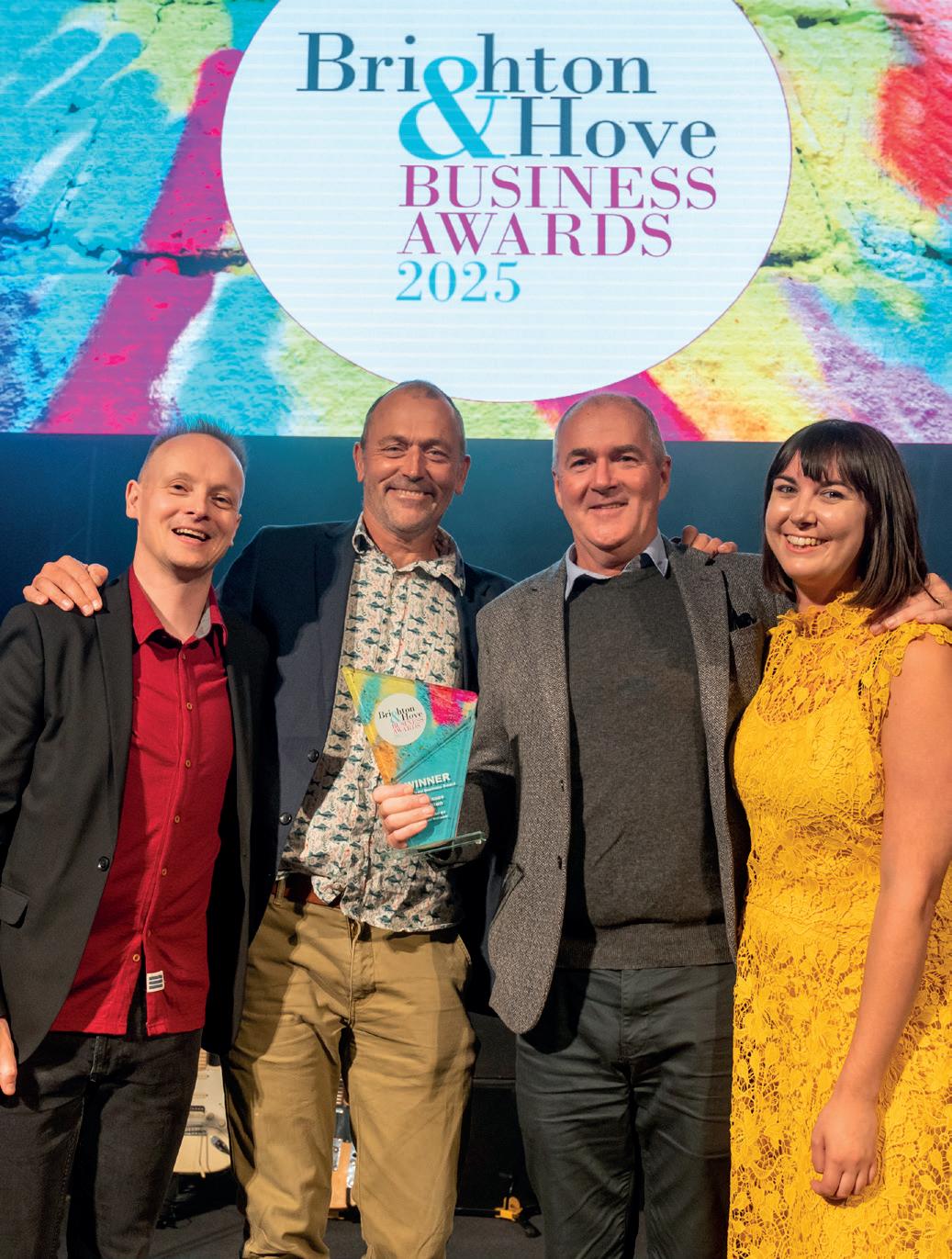
After hours of reading, interviewing and reflecting, one business captured all four of these qualities in a way that felt truly transformative: Sea Lanes Brighton. They built more than a brilliant open-air pool; they created a hub that brought together 19 local fitness, health, food and wellbeing businesses under one roof. In doing so, they proved that success isn’t just about growth or profit, but about creating opportunities for others to thrive too.
Sea Lanes showed bravery in tackling a complex, highrisk project, resilience in overcoming years of planning and funding challenges, agility in starting with a pop-up model before scaling, and focus in their long-term vision of building a healthier, more connected community.
They truly personified the power that new businesses have to grow the communities around them and inspire the next generation, who I hope to be back judging next year.





Pippa Moyle CEO + Founder citygirlnetwork.com
Our Communities: Brighton, London, Manchester, Bristol, Bath, Leeds, Edinburgh, Birmingham, Worthing, Liverpool, Newcastle, Chester, Milton Keynes, Oxford, York, Cardiff, Glasgow, Perth and Rural Sussex
Laura Hearn is a former BBC journalist, now storytelling consultant and founder of Flip It - a podcast and platform helping people and businesses use storytelling as a tool for clarity, connection and change. This month, for Dynamic, Laura examines the various meanings of ‘excellence’

“Your personal story is your secret weapon. What you leave in and leave out makes all the difference.”
By Laura Hearn
Ican’t say I love long drives, but they’ve become my classroom - time to listen to a podcast and arrive with a new perspective. Recently, I listened to Emma Grede in conversation with Mel Robbins. Emma is the founding partner of SKIMS, co-founder and CEO of Good American, host of @aspirewithemmagrede - and a mum of four (no imposter syndrome here).
The interview held my attention for the entire 1 hour and 26 minutes, which is rare. And although there was so much that stood out for me, if I had to choose one idea, it would be this: “Be excellent at where you are, at whatever you are doing, because that has some kind of invisible magnetic pull.”
Excellence.
But what does excellence mean? Like all words, it means different things to different people. It’s easy to imagine excellence belonging to the big milestones in your life - a promotion, getting married, buying a house. But what if it’s less of a headline and more of a few words hidden in the back pages?
What if it’s as simple as the way you make your coffee, write an email, or speak to yourself when you’re on your own? As a journalist, I’ve listened to some extraordinary people tell me that their greatest breakthroughs didn’t come from polished perfection, but from the moments they were kneedeep in difficulty, scrambling to find a way forward, when they kept going, clinging to curiosity and courage, despite having no idea when or where they would resurface.
PURSUE YOURSELF FIRST
Who do you spend more time with than anyone else? You. It’s something we easily overlook, but the only person who will always be by your side is you, so you might as well enjoy the company.
In business, especially for women, it’s tempting to measure success against external markers, such as turnover, recognition, and productivity. But above all of it is the inner story we tell ourselves. Too often, it’s a story of criticism.
What if excellence included how we speak to ourselves? What if, when something goes wrong, we responded as we would to a close friend, with kindness and encouragement rather than judgment?
Excellence, in this sense, isn’t about performance. It’s about self-trust. And from that foundation, everything else follows.
Something else Emma shared was this: “If you don’t know if you’re going in the right direction, then just go. At least you’re moving.”
I hear this dilemma a lot in my work with leaders and entrepreneurs: “What if I get it wrong? What if this isn’t the right path?”
But there rarely is a wrong or a right path. If you choose to look at it that way, you will only ever arrive if you begin. You only find clarity once you’re moving. Even the wrong turns add to your story - the lessons, the resilience, the connections that shape the next stage. As Emma put it: “Everything you want is already there, it just has to find you working.”
It’s about:
• Starting where you are.
• Speaking to yourself with the kindness you extend to others.
• Moving, even without a perfect plan.
• Choosing excellence in today’s small actions. Those repeated acts build the confidence and momentum that attract the next opportunity.
At its heart, this comes back to story – my favourite thing. What you tell yourself about where you are and where you’re going matters.
“In journalism, striving for excellence was also an ethical responsibility. It wasn’t about polish for its own sake, but about truth and respect for the audience.”
The paradox is that the more you focus on doing the small things well, the more opportunities begin to open up.
I saw this in the BBC newsroom. The interviews that made the biggest impact weren’t always with the most famous names, but the moments when I listened closely, asked the unexpected question, and was gifted with a nugget of gold. Excellence, in that sense, wasn’t about bigger. It was about paying attention to the little things.
And it wasn’t optional. In journalism, striving for excellence was also an ethical responsibility. It wasn’t about polish for its own sake, but about truth and respect for the audience. The same applies in business. Excellence is how you honour the people you serve. It’s not about perfection or performanceit’s about doing the work with care so others can trust you.
For women leading businesses or building careers, excellence can feel like another impossible standard. But this isn’t about pressure. It’s about reframing excellence as something human and attainable.
When I work with clients on their brand narrative or personal story, I often ask: “What’s the story you’re telling yourself right now?” Because if that story is full of doubt and self-criticism, everything feels harder. But if it’s built on trust and a commitment to small acts of excellence, momentum begins to build.
A QUESTION TO TAKE AWAY
So, the question I’ve been asking myself since hearing Emma Grede’s words is: ‘What would excellence look like for me today, right where I am?’
For me, it can be as ordinary as making my bed. Sometimes it’s finishing the email I have kept in my drafts all week. And sometimes… (more than sometimes) it’s listening with my full attention.
Don’t wait to be excellent. Be excellent now, in your own way. Because as Emma says, “how you do anything is how you do everything. Excellence isn’t the endpoint. It’s the practice that shapes the story you’re writing - one choice at a time.

You can listen to Laura’s podcast, Flip It, wherever you get your podcasts, and you can connect with her at www.flipitglobal.com
Natalie Montagnani is the founder of IGNITE and a senior business strategist with 25 years of experience in marketing and growth consulting. She helps ambitious women — from corporate leaders to entrepreneurs — to scale with strategy, elevate their influence, and lead with confidence. IGNITE also supports companies committed to advancing female leadership and driving real change.
Inmy brief stint as an employee working within corporate, I was always waiting. Waiting for a pay rise. Waiting for recognition. Waiting for promotion.
It was at the tender age of 27 that I gave up wishing and hoping and started my own marketing agency. It felt empowering to take control; to be master of my own destiny even though the road has been full of its own challenges over the years. But entrepreneurship isn’t for everyone – and also, shouldn’t we stay in the game and fight the good fight?
For years, we’ve been encouraged to lean in, speak up, negotiate harder, and take the seat at the proverbial table like good little girls with straight backs and strong handshakes.
But here’s the problem: The table wasn’t built for us, and we are often made to feel like an outsider even once we’ve ‘made it.’ I’ve had clients tell me about how they are often spoken over, not listened to and generally made to feel ‘less than’. And so, these brilliant, successful women have quit – and that’s a travesty. Why is this happening? Because some companies promote women to boards just to tick the DEI box, not because they respect their contribution – it’s just a way for them to keep the old boys club going a little longer.
ourselves in the process - changing how we speak, lead, and dress.
I’ve seen vast swathes of women ‘acting’ like men in order to get ahead. I remember once terrifyingly reading an article about women taking testosterone so they could be less emotional and literally be more like a man. WTF? But here’s the truth: We were never meant to blend in. So what do we do?
Just like I did back in the day, women are still waiting to be invited into leadership. Into opportunity. Into the spotlight. We hesitate. We ‘just want to check we’re qualified enough’ We overthink. We ask: “Am I too much? Am I ready? Am I allowed?” Meanwhile, men are skipping their way into boardrooms they’re barely qualified to sit in - and never questioning if they belong.
“We’ve been taught that there’s one table and a few lucky seats for women who ‘play the game right.’ Forget that. Bring your own chair...”
Just like that infamous Hewlett Packard internal report ‘Men apply for a job when they meet only 60% of the qualifications, but women apply only if they meet 100% of them.’ The system is never going to hand us the power. So what’s the solution?
Simple. Bring your own chair.
BEING A WOMAN IS OUR GREATEST STRENGTH
The rules were written decades ago by men in grey suits with stay-at-home wives and full-time secretaries. And while we’ve squeezed ourselves into the game, we’ve also contorted
Let’s be real, the old model of leadership is tired. It’s performative, aggressive, and outdated. The future? It’s female, collaborative, creative, emotionally intelligent, and wildly effective – these are the superpowers of modern leadership.
By Natalie Montagnani

In fact, studies consistently show that organisations with women in senior leadership roles outperform those without. Why? Because women leaders are more likely to coach and develop their teams, build inclusive cultures, and drive higher engagement.
And this is proven. McKinsey & Company found that companies in the top quartile for gender diversity on their executive teams were 25% more likely to have above-average profitability.
Still, the myths persist:
“Women are too emotional.”
“Women lack authority.”
“Women don’t go hard enough.”
Absolute rubbish.
The data tells a different story. Studies show women outperform men in almost every key leadership metric - from team engagement and collaboration, to ethical decision-making and long-term vision.
The fabulous Simon Sinek said it plainly: “Women make the best CEOs. Not because they lead like men, but because they don’t. Men want me to prove that trusting people, loving people, taking care of people is a good thing for business. Women inherently understand that and make decisions accordingly.”
STRONGER TOGETHER
Let’s be clear: bringing your own chair doesn’t (and can’t) mean doing it alone.
It simply means:
• Backing yourself before anyone else does
• Creating your own opportunities when the system stalls
“Here’s the problem: The table wasn’t built for us, and we are often made to feel like an outsider even once we’ve ‘made it.’”
• Surrounding yourself with other women who are also building, rising, and disrupting
• Being more visible as a leader
• Building a strong personal brand that clearly demonstrates your expertise and demands attention
• Get comfortable having uncomfortable or even challenging conversations
• Working on you, your mindset, your confidence levels
• Supporting other women who need a hand up (collaboration over competition)
Be the change – because as humans, we often need someone to follow; be that role model. A 2022 study found 43% of women believe they would be more successful if they had a female role model in the workplace – so be her.
This is why I built IGNITE, a space for ambitious women to stop waiting, start owning their brilliance, and build careers, businesses and lives that reflect who they truly are, and supporting organisations that know they need to change and who truly want to embrace it.
Whether you’re an entrepreneur, executive, or emerging leader, you don’t need permission to take up space. You just need support, strategy, and a little reminder of how powerful you already are.
We’ve been taught that there’s one table and a few lucky seats for women who “play the game right.” Forget that. Bring your own chair, and then start pulling up more for the women behind you. Because we’re not here to fit in. We were born to lead, and it’s time to rewrite the rules of leadership.
Are you in?
Natalie Montagnani Founder of IGNITE Women in Business
07900 153503 Ignitewomeninbusiness.com
Many people who have come to the UK are fed up of the narrative that the country’s problems are down to them. Tess de Klerk, drawing on her own experiences, puts the record straight
Brexit was the first wound. Many immigrants felt it deeply personal - the majority of Britain’s population seemingly deciding that people like us were no longer welcome. Many EU citizens left Britain altogether, heading back to their homelands, exhausted and disheartened.
Since then, the rhetoric has been mostly aimed at so-called illegal immigrants. Now, politicians hardly bother with that distinction. We are all lumped together, vilified simply for existing here.
Robert Jenrick, Shadow Justice Minister, laid it bare when he recently said: “Damaging though illegal migration is, legal migration is even more harmful to the country because of the sheer eye-watering numbers of people who have been coming across in recent years perfectly legally – it’s putting immense pressure on public services.”
In one sentence, he erased the difference between those who play by the rules and those who don’t. For those of us who have sacrificed so much to build a life here, those words
sting deeply. They confirm what many already feel: no matter how much we contribute, Britain’s politicians will still blame us.
I know this first-hand. I came to the United Kingdom from South Africa more than a decade ago. I worked tirelessly - sometimes juggling three jobs - while paying taxes and contributing to the NHS, all without being entitled to the safety of benefits if things went pear-shaped. For ten years, I applied for visa after visa, each time at my own personal cost.
The fees are punishing: a family visa application costs £1,321 per person, on top of the NHS surcharge of £2,587 payable in advance for several years at a time, plus possible solicitors’ fees, as the applications can be minefields. These visas often have to be renewed every two and a half years before eventually applying for Indefinite Leave to Remain (ILR) - each stage costing thousands more.

Many immigrants are not on visas that count towards ILR, and are prevented from applying after five years. My own journey took ten years. By the time I finally secured ILR, I had spent a small fortune just for the right to stay in the country where I was already contributing. It should have been a moment of
“Indefinite Leave to Remain is not a gift; it is earned.”
recognition. Instead, in today’s Britain, even people like me who have followed every rule are being told we are the problem.
The truth is far removed from the scaremongering. Immigrants are not draining Britain - they are keeping it afloat. Recent figures show that skilled worker visa holders in 2022/23 had a net fiscal contribution of £16,300 each, compared to around £14,400 for UK-born adults. Immigrants, in other words, are contributing more to the Treasury than the average Briton. Between 2001 and 2011, migrants from the EEA contributed £22 billion more in taxes than they took out in services, while non-EEA migrants contributed £2 billion more. These numbers prove what the rhetoric denies: immigration is not a burden but a benefit.

It is also important to remember who the immigrant population is. Migrants are disproportionately young and working-age. They come to Britain in their 20s and 30s, the years when people are generally at their healthiest, least reliant on the NHS, and most economically productive.
Most leave after a few years or when they grow older, often returning to their countries of origin before they ever reach the stage of life when people draw heavily on healthcare. That means Britain benefits from their taxes and their labour during their prime years, without bearing the longterm healthcare costs that come with ageing.
The NHS is a perfect example. Around one in six NHS staff is an immigrant, and almost 40% of doctors trained abroad. Without them, the system would collapse. The same is true of social care. In 2023/24 alone, over 100,000 care workers had to be recruited from overseas to fill gaps left by dangerous and chronic shortages.
Those posts were available to people living here, but they weren’t filled. The truth is, without immigrant care workers, hospitals would overflow, care homes would shut down, and vulnerable people would be abandoned. Many of these recruits are not just care workers but qualified nurses and health professionals in their countries of origin, bringing expertise Britain needs.
Nigel Farage and others have spent years peddling myths:
• Immigrants take British jobs - False. Studies consistently show that immigration has little impact on employment for UK-born workers. Instead, immigrants fill the jobs others cannot or will not do, especially in healthcare, social care, and hospitality.
• Immigration causes the housing crisis - False. Britain’s housing crisis is decades in the making, caused by underinvestment and poor planning - not by immigration.
• Immigrants drain welfare. False. Most immigrants have no access to benefits for years, yet they pay taxes from day one. They are net contributors.
• We can’t get GP appointments because of immigrants - False. GP shortages are driven by chronic underfunding and a shortage of medical training places. In fact, thousands of GPs and practice nurses are immigrants - without them, waiting times would be even worse.
• The NHS is collapsing because of immigration - False. The NHS is collapsing because of years of austerity and neglect. Immigrants are propping it up, not breaking it down.
These are not just harmless lies. They create division, fuel resentment, and leave immigrants like me feeling unwelcome in the country we help sustain.
FARAGE’S CRUEL FANTASY
Farage’s latest half-baked idea - rescinding Indefinite Leave to Remain - is not only cruel, it is unworkable. He proposes replacing ILR with renewable visas every five years, with stricter salary thresholds and conditions.
This would destabilise hundreds of thousands of people’s lives, including many who have lived in Britain for decades, raised families, and built careers. It would devastate the NHS and care system by driving away essential staff. And it would send a chilling message to every immigrant: no matter how long you’ve been here, you will never belong.
problem, it feels like a finger pointed at me, at my daughter, at others like us. I know countless immigrants who feel the same: we work hard, we contribute and yet we are told we are not wanted.
It is demoralising, it is exhausting, and it is deeply personal. And it’s becoming frightening. As my friend who has lived here for close to 15 years said after she drove to work one morning with St George’s flags ominously lining miles of road: “Things are getting scary - it’s making me think of Europe many decades ago”
Britain faces an ageing population, workforce shortages, and an overstretched NHS. Immigration is not the problem - it is the solution. Without it, pensions would become unsustainable, hospitals would collapse, and social care would disintegrate. The problem is not the immigrant workforce; it is the mismanagement of the country over decades, combined with a lack of political will to invest in housing, infrastructure, and public services.
“Here is the challenge: to politicians who peddle lies for votes, stop scapegoating us and start addressing the real problems.”
ILR is not a gift; it is earned. People like me spent years following every law, paying every fee, and proving our worth. To strip that away retroactively is nothing short of betrayal. This feels personal
The facts matter, but the human toll is more difficult to quantify. Every time a politician says immigration is the
I came to Britain because I believed in its values of equality, opportunity and openness. I still want to believe. But the rhetoric tells me I will never truly belong here, no matter how much I give.
Here is the challenge: to politicians who peddle lies for votes, stop scapegoating us and start addressing the real problems. To the public, look at who is helping keep the hospitals, care homes and farms running. And to Britain as a whole: decide whether you want to be a country that thrives by embracing reality, or one that declines by chasing myths. Immigrants are not the enemy - we are part of the solution, and it’s time Britain’s leaders had the courage to say so.

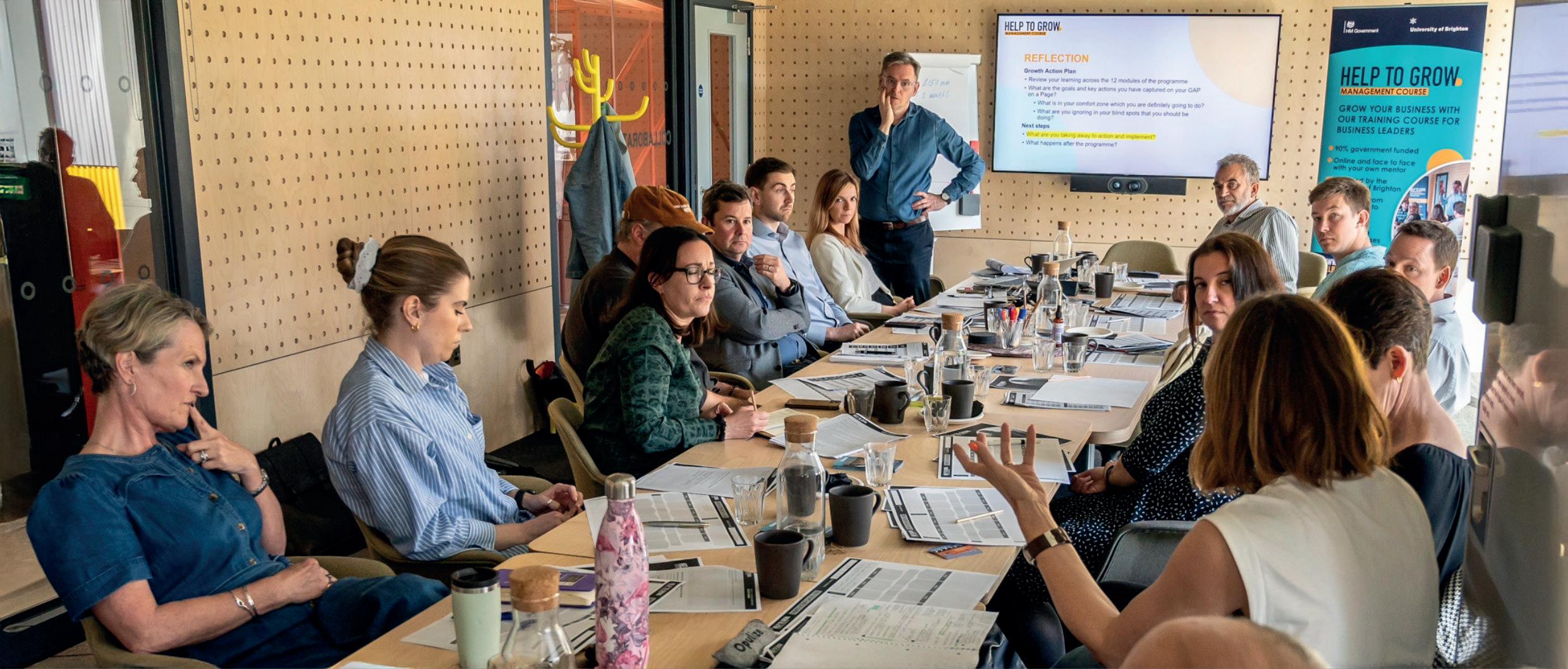
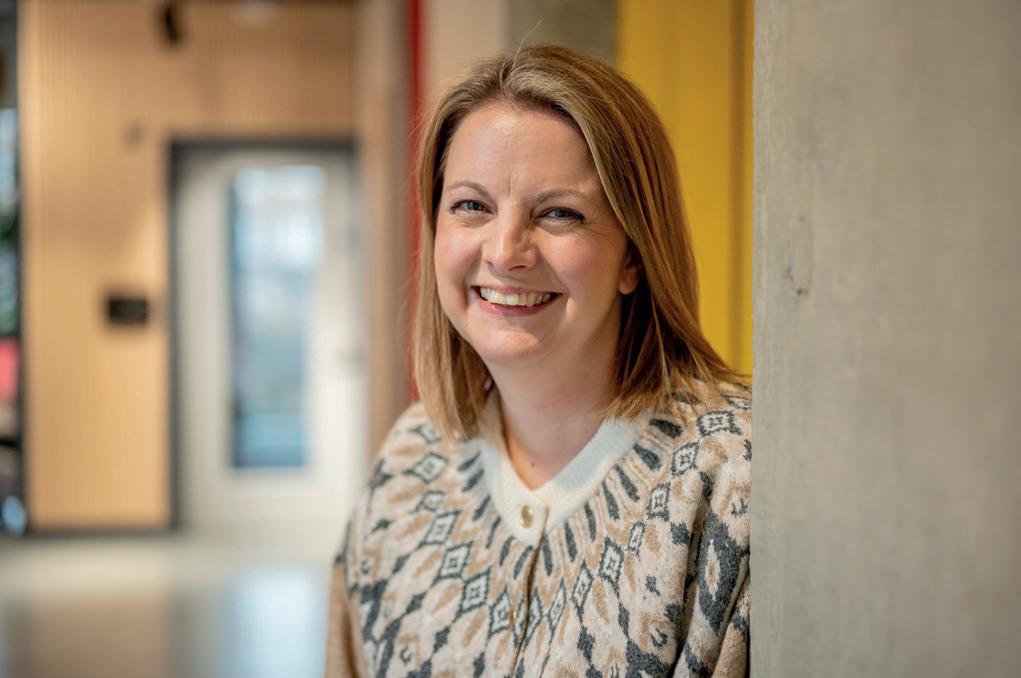



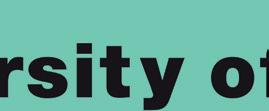



































































































































































































































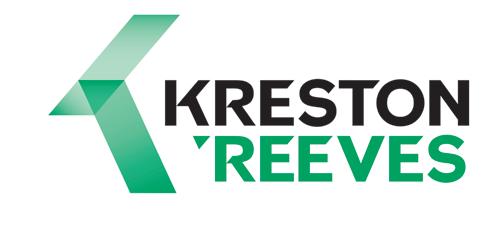


















































































































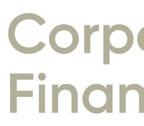
















The United Kingdom’s top foreign spook is, for the first time, a woman. The new boss of MI6 – or to give its correct title, ‘Secret Intelligence Service (SIS)’ – is referred to as ‘the Chief’ or more commonly as ‘C’, and is the only member of staff who is publicly named.
In a case where life finally imitates art (Dame Judi Dench having played ‘M’), Blaise Metreweli became the 18th Chief of the SIS on October 1st.
She reports directly to the Foreign Secretary, Yvette Cooper, and is responsible for ensuring the UK operates securely all over the world in our mission to keep the country safe.
By Alan Wares
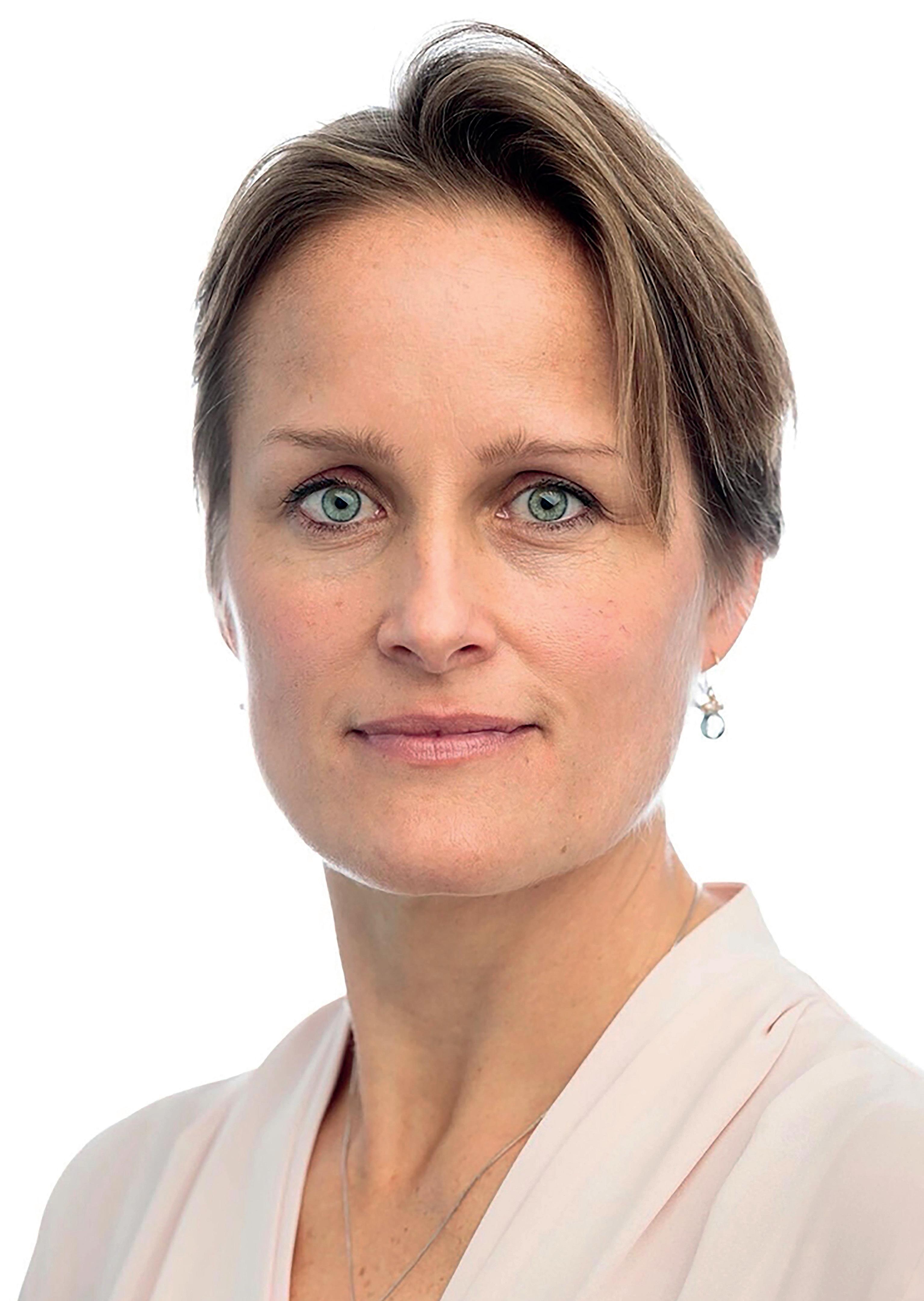
Despite its commonly known ‘MI6’ handle, the organisation’s correct title is the Secret Intelligence Service (SIS).
It is tasked mainly with the covert overseas collection and analysis of human intelligence on foreign nationals in support of its Five Eyes partners (Australia, Canada, New Zealand, the United States, with the UK making the fifth partner). SIS is one of the British intelligence agencies, and the Chief of the Secret Intelligence Service (known as “C”) is directly accountable to the Foreign Secretary.
The reference to ‘C’ is from the first Chief of the service, Sir Mansfield Cumming, who would sign his orders with just that monogram. By way of jocular expression, Ian Fleming took the first Chief’s other initial - ‘M’ - and used that as a reference to the top person in his James Bond series of novels.
Formed in 1909 as the foreign section of the Secret Service Bureau, the section grew greatly during the First World War, officially adopting its current name around 1920. The name “MI6” originated as a convenient label during the Second World War, when SIS was known by many names. It is still commonly used today. The existence of SIS was not officially acknowledged until 1994.
That year, the Intelligence Services Act 1994 (ISA) was introduced to Parliament to place the organisation on a statutory footing for the first time. It provides the legal basis for its operations. Today, SIS is subject to public oversight by the Investigatory Powers Tribunal and the Intelligence and Security Committee of Parliament.
The stated priority roles of SIS are counter-terrorism, counter-proliferation, providing intelligence in support of cyber security, and supporting stability overseas to disrupt terrorism and other criminal activities.
Unlike its main sister agencies, Security Service (MI5) and Government Communications Headquarters (GCHQ), SIS works exclusively in foreign intelligence gathering; the ISA allows it to carry out operations only against persons outside the British Islands.[9] Some of SIS’s actions since the 2000s have attracted significant controversy, such as its alleged complicity in acts of torture and extraordinary rendition.
Since 1994, SIS headquarters have been in the SIS Building at Vauxhall Cross, on the South Bank of the River Thames in London,.
Blaise Metreweli CMG took over from the outgoing Sir Richard Moore on October 1st to become the 18th person to hold the title of ‘C’, having previously held the role of Director General of Technology and Innovation within the SIS. One does love a title…
Although publicly named and acknowledged by HM Government, details of Metreweli’s background are - understandably – a bit patchy. Except to others in the espionage community, one presumes.
Blaise Metreweli was born in 1977 and spent part of her childhood in Hong Kong. She attended Cheltenham Ladies’ College and graduated in 1993. She subsequently attended Westminster School in London. From 1994 to 1995, Metreweli was captain of Westminster School. She then studied anthropology, graduating with a Bachelor of Arts from the University of Cambridge in 1998, a well-trodden breeding ground for international espionage.
While at Cambridge, alongside future Olympians Sarah Winckless, Francesca Zino and Alison Mowbray, she was a member of the Cambridge University Women’s Boat Club Blue Boat crew that won the 1997 Women’s Boat Race against Oxford University.
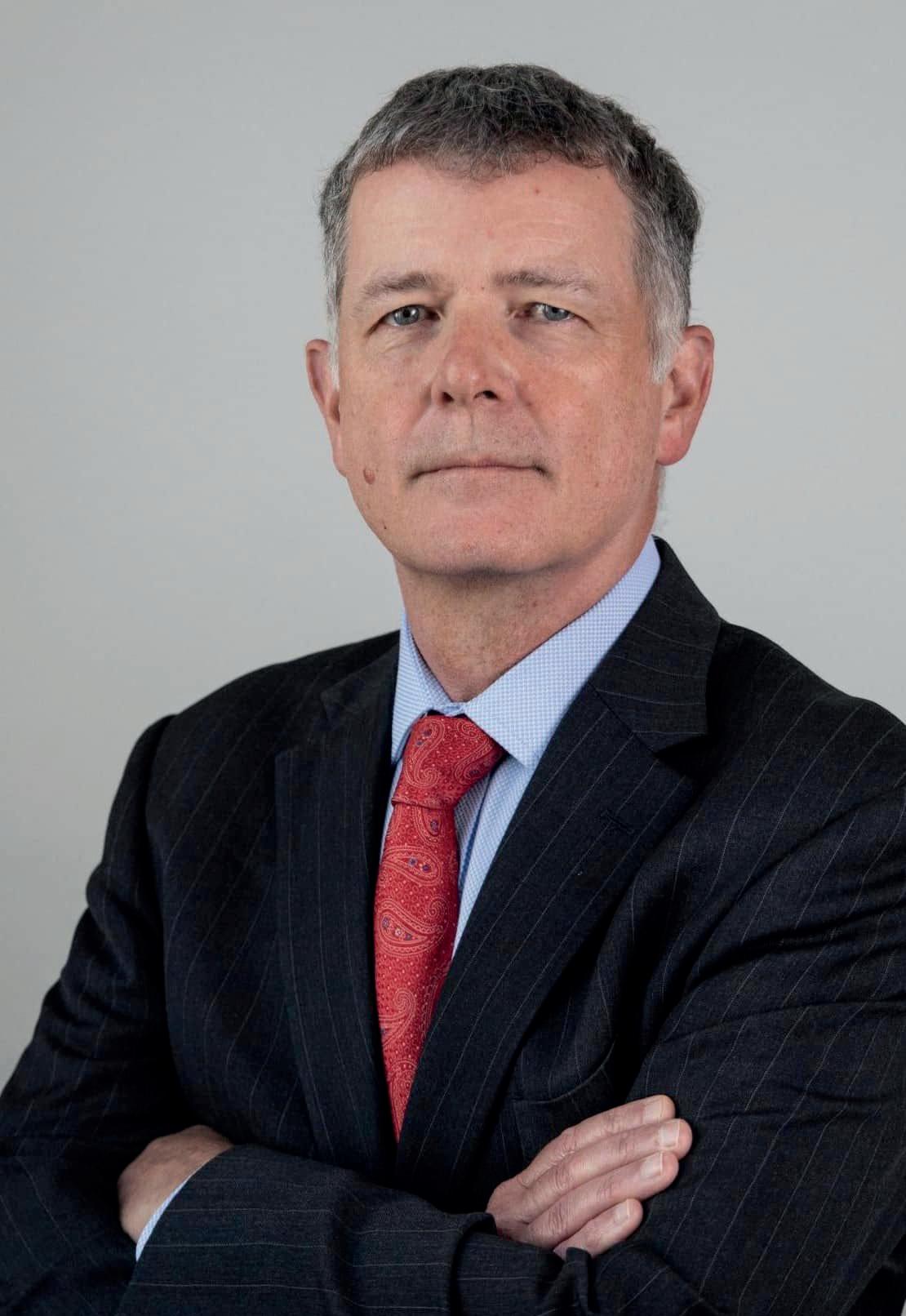
The outgoing ‘C’ – Sir Richard Moore

“Details of Metreweli’s background are - understandably – a bit patchy. Except to others in the espionage community, one presumes.”
Metreweli’s father, Constantine Metreweli, was born Constantine Dobrowolski, himself the son of a Nazi collaborator, in Snovsk in the Chernigov Oblast of the Nazioccupied Ukrainian Soviet Socialist Republic in 1943. He came to England with his mother, who then married David Metreweli in Yorkshire in 1947.
After attending The Latymer School, the University of Cambridge and the University of Oxford, he became a physician and radiologist and was chair of diagnostic radiology at the Chinese University of Hong Kong. He also trained in the British Army, and did a medical residency in Riyadh from 1982 to 1985. He had taken the surname Metreweli, which is of Georgian origin, from his stepfather.
After the Daily Mail – which at times still likes to think communism still exists, and re-live old Cold War sentiment and conspriacy – broke the story about Metreweli’s paternal grandfather in June 2025, following the announcement that Metreweli was going to be head of MI6, the Foreign & Commonwealth Office (FCO) stated that she had never known him and that her complex Eastern European heritage had “contributed to her commitment to prevent conflict and protect the British public from modern threats from today’s hostile states, as the next chief of MI6”.
In other words, the FCO was more than happy with her appointment and, unusually, confirmed as much in public.
The building was opened in 1994, hiding in plain sight, after the SIS had had several splintered offices across South London. By the 1980s, the SIS, especially during the Cold War, gave up any pretence of trying to hide in amongst Lambeth’s narrow streets. If London cabbies knew where they were dropping off their customers (‘Oh, you mean Spook House, guv?’), then their Soviet bloc counterparts certainly would have known where they operated from.
Since its inception, Vauxhall Cross (or 85 Albert Embankment, Vauxhall, Lambeth, to give its full address) has been referred to by many names, both from within and without.
• MI6 Building
• Legoland
• Ceaușescu Towers
• Babylon-on-Thames
• Vauxhall Trollop
• The Ziggurat
• The Palace of Light & Culture
Meanwhile, the relationship between themselves and their north-of-the-Thames sister service, MI5, runs more like an ongoing sibling spat. MI5 refer to the SIS at ‘TSAR - Those Shits Across the River’). The feeling, apparently, is mutual.
Incidentally, despite what the last few James Bond films might portray, Vauxhall Cross is still in one piece, and hasn’t been blown to smithereens by Spectre.
Metreweli joined SIS in 1999, and spent much of her early career in the Middle East, at a time when Britain was involved militarily in Afghanistan and Iraq. Since that time, she has worked continuously as an intelligence officer, including director-level roles at MI5. (While the head of the SIS is known as ‘the Chief’, the head of MI5 is ‘the Director General’).
Metreweli’s roles in intelligence have included senior positions in the Middle East, where, for obvious reasons, she is fluent in Arabic. Her focus on counterterrorism has required her to address state threats against a backdrop of complex geopolitical issues, including China’s biometric surveillance and cyberattacks by Russia. From 2000 until 2003, Metreweli was Second Secretary for Economic in Dubai, for the FCO. Around the time that John Sawers became Chief of MI6 in 2009, Metrewli was heading up an MI6 station in the Middle East.
During her career, Metreweli has given newspaper interviews: to The Telegraph in 2021 (under the code name “Director K”), and to the Financial Times in 2022 (under the pseudonym “Ada”).
As of December 2021, she was on secondment as Head of Hostile States Counterintelligence (“Director K”) to MI5. As of June 2025, Metreweli was Director General of Technology and Innovation (euphemistically referred to as “Q”) at SIS. At that time, and for the fi rst time, three of the four SIS directors-general were women.

Foreign Secretary Yvette Cooper, to whom Metreweli will directly report
be the third chief (out of 18) who graduated from Pembroke College, Cambridge.
RECOGNITION
Metreweli was appointed a Companion of the Order of St. Michael & St. George (CMG) in the King’s Birthday Honours for 2024, where she was listed as “Director General, Foreign, Commonwealth and Development Office” with a citation of “For services to British Foreign Policy”.
“To underline the next-cab-off-the-rank approach from Cambridge to Vauxhall Cross, she
will be the third chief (out of 18) who graduated from Pembroke College, Cambridge.”
In June 2025, Metreweli was announced as the next chief of the Secret Intelligence Service (MI6). There were four candidates for chief of the SIS: three from the British intelligence agencies and Barbara Woodward from the Foreign Office. Metreweli is the fi rst female head of MI6, who is known as “C”.
Reacting to Metreweli’s appointment, outogoing Chief Sir Richard Moore said: “I am absolutely delighted by this historic appointment of my colleague, Blaise Metreweli to succeed me as ‘C’. Blaise is a highly accomplished intelligence officer and leader, and one of our foremost thinkers on technology.”
As chief of MI6, she will become the only publicly named member of the service. To underline the next-cab-off-therank approach from Cambridge to Vauxhall Cross, she will
Well, that’s the official version… WOMEN IN TOP ROLES
Incidentally, if you think we’ve been here before with female secret services bosses, Dame Stella Rimington became the fi rst woman director general of the real MI5 after working in different roles in the service since 1969.
In 2002, Eliza Manningham-Buller became the director general of MI5 after working for the service since 1974. Anne Keast-Butler currently leads GCHQ. She was previously the deputy director general of M15.
Meanwhile in the US, Tulsi Gabbard currently serves as the director of national intelligence for President Donald Trump. Her predecessor under former US President Joe Biden was also a woman, Avril Haines.
Gina Haspel was the director of the Central Intelligence Agency (CIA) from 2018 to 2021. In Australia, Kerri Hartland leads the foreign intelligence collection agency, the Australian Secret Intelligence Service (ASIS).


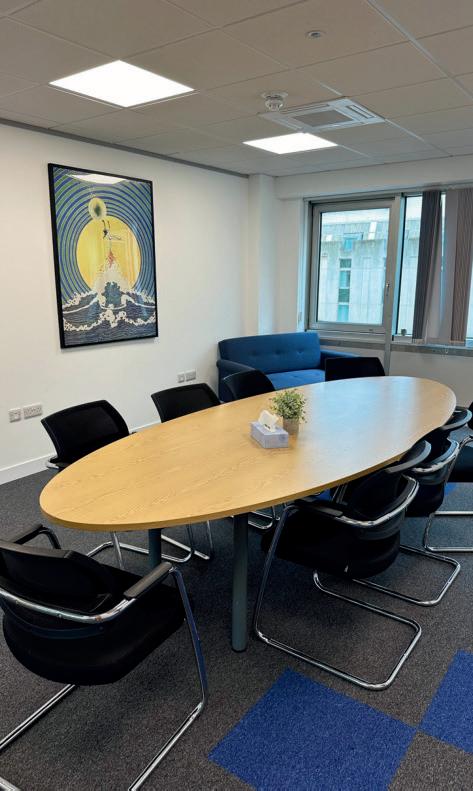


Honest Pricing
Managed Space
Super Fast Internet (1GB Dedicated Shared Line)
Printing
Utilities
Access to Members Directory
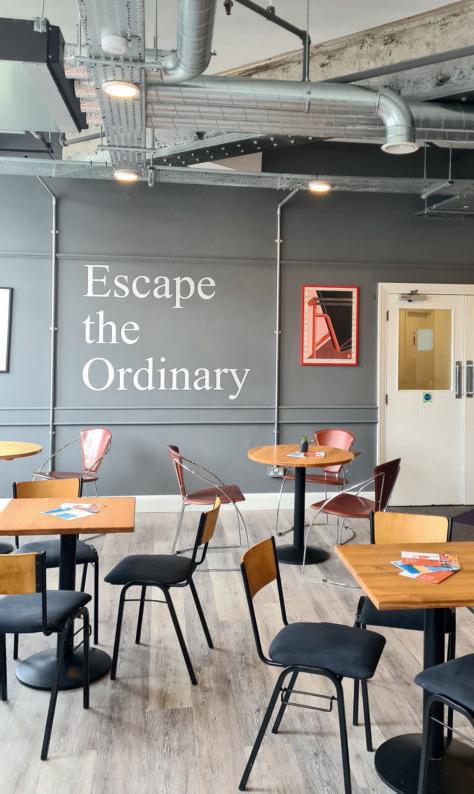
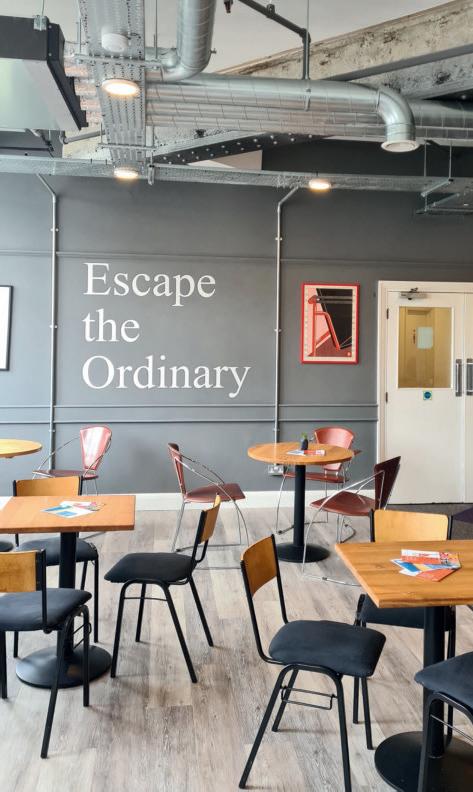
Open Plan Kitchen / Breakout Areas
Access to Barclays Eagle Labs Business Support
Unlimited Refreshments
FREE Beer Friday
Tailored Member Networking
Professional Enviroment


Businesses can utilise lessons from our evolutionary history to produce positive results for both companies and staff. By Mary Taylor, director at Mary Taylor & Associates
New research conducted by leading business consultancy and executive coaching firm, Mary Taylor & Associates, has shown that recognising and embracing behavioural, cultural and societal elements stemming from the earliest days of our species can lead to a happier, more committed workforce.
For much of human history, the majority of people led hunter-gatherer lifestyles, characterised by close-knit, long-term cooperation and flexible relationships between numerous individuals. These communities featured relative equality among members of the group, direct access to leaders, opportunities to participate in decision-making, and high levels of personal responsibility and autonomy.
research revealed a strong correlation between this lack of satisfaction and lack of access to senior leaders, with only 12% of frustrated respondents having direct access.
Happiness and satisfaction levels rose progressively with increased access to leaders, to over 80% of participants who were ‘very happy’ and ‘extremely happy’ in their work, citing significant direct access to senior leaders.
“We can all learn from our evolutionary past to build better, more inclusive, productive, and happier workplaces.”
In stark contrast, 21st century businesses often consist of rigid hierarchies, large group sizes, relative inequality between people, and low levels of personal choice, even about fundamentals such as when, how, and where to carry out tasks.
These fundamental differences, which have occurred only very recently (evolutionarily speaking), mean that people often function and respond in many aspects in the same ways as our distant ancestors. As a result, they often conflict with modern working systems and practices.
What follows is proof that we can all learn from our evolutionary past to build better, more inclusive, productive, and happier workplaces.
Of the modern workforce surveyed in the research, over 40% said they were, at best, ambivalent about their employment, with 15% reporting they were actively unhappy. The
Beyond access to senior staff, only 12% of unhappy and dissatisfied workers reported having any significant participation in decision-making. Levels of participation in decision-making and satisfaction rose in tandem, culminating in 71.9% of those surveyed who were ‘extremely happy’, enjoying significant participation in these processes.
85.4% of participants who were ‘extremely happy’ in their work reported having significant responsibility and status, while only 12% of dissatisfied workers said they experienced significant responsibility and status.
Following the same pattern, increased happiness and satisfaction levels were recorded with progressively greater levels of autonomy at work. Specifically, 85.3% of participants who reported being ‘extremely happy’ in their work indicated having significant autonomy and independence.
OUR NATURAL STATE FOR BUSINESS
Whilst there are self-evidently many contributing factors to any individual’s happiness and satisfaction at work, and none of the above elements (either by themselves or in combination) can be said definitively to be ‘the cause’ of differing levels of professional happiness and satisfaction, this does not diminish the clear, very strong correlations.
Such strong results overwhelmingly suggest that to increase
general levels of happiness and satisfaction at work, companies should seek to provide employees at all levels with at least some degree of direct access to senior leaders, participation in decision-making, responsibility and status, and autonomy and independence in their work.
The fact that so many individuals who are happy have high levels of these factors provides food for thought around how to increase involvement in decision-making or autonomy at work for entry-level employees. Where such factors are often negligible, or simply not present at all, unhappiness levels are particularly high, which has a knock-on impact on the business.
Should companies be interested in increasing the happiness and satisfaction of all employees? The answer is obviously ‘yes’ for common quantitative issues, such as staff retention, reducing days lost to sickness, operational efficiency, and increased performance, among others. But there are also the qualitative benefits, such as staff loyalty, brand reputation and company culture, just to mention a few.
Making changes such as increasing direct access to leaders or increasing involvement in decision-making for all levels of employees can actually be reasonably simple and low-cost options for most companies.
For example, even 5-10 minutes of direct access to a senior leader by an entry-level employee once every few months can produce significant returns, not only for the employee but also for the leader, where a new and fresh perspective or ‘insider knowledge’ can produce invaluable insights.
Mind-boggling amounts of time, money, and energy are continuously spent around the globe on trying to find the latest ‘hack’, technique, leadership style, algorithm, and so on, to solve business or work problems or increase or decrease some metric or another. Occasionally, these work brilliantly, but more often than not, they don’t.
Conversely, what are usually routinely ignored are the ‘natural’, relatively cheap and simple interventions that can produce really radical shifts in business and professional performance and results.
“Should companies be interested in increasing the happiness and satisfaction of all employees? The answer is obviously ‘yes’”
Mary Taylor has worked with top executives in many globally recognised brands, including Apple, Cartier, Ferrari, Dior, Pfizer, Prada and Sony, from which she has developed a unique understanding of corporate life at the top and the challenges faced by the people there.
Traditional business coaching and consultancy is often criticised for lacking bite, providing little in the way of practical solutions or positive measurable outcomes. Mary Taylor’s approach is very different. She views coaching and consultancy as being much more about real-world actions, lateral solutions, new ideas and tangible results.
Mary’s extraordinary academic and professional background includes working as a leader in maximum-security prisons, as a top corporate lawyer and a qualified psychologist. Mary has over 20 years of experience as a coach and consultant, and draws on this wealth of knowledge to deliver hard-hitting advice and recommendations that have had major impacts on leading organisations across the world.
Suppose a company is interested in producing disproportionately large returns on investment for the time, money, and effort being spent on overcoming a range of issues. In that case, these results suggest that optimising business procedures to take advantage of our natural, inbuilt, evolutionary characteristics and behaviours will, more often than not, contribute significantly to achieving the desired results.
Research was gathered from a population of full and part-time employees, with approximately even spreads across genders, ages, job levels, US geographical regions and household incomes, with a margin of error of +/- 5.573%

In our exclusive Spotlight feature, we highlight women who are doing good things in their community. They’re not always seen but we think they should be.
Kate is the dynamic founder and CEO of Diamond Logistics where she is driving growth and championing values
Kate has built one of the UK’s most forward-thinking delivery and fulfilment networks - and she’s done it with a blend of bold ambition, rock-solid values and a deep commitment to people. Under her leadership, Diamond has achieved annual turnovers of eight figures and contributed over £100 million to the UK economy in recent years. This isn’t just a story about financial growth; it’s about how vision, culture and purpose can power long-term success.
From the outset, Kate’s mission has been to transform the logistics landscape by blending technology with human connection. Through the company’s proprietary platform, Despatchlab, Diamond gives clients complete visibility, control and efficiency whether they’re fast-growing e-commerce brands, national retailers, or local businesses needing same-day courier services. But beyond the innovation, Kate places equal emphasis on the relationships behind the business.
Central to Diamond’s success is a culture of collaboration and empowerment. Kate believes in surrounding herself with capable, motivated people and then giving them the freedom to excel. She’s a strong advocate for inclusive leadership, ensuring that every voice within the organisation is valued. “Business is about people first,” she often says, reflecting her belief that happy, supported teams are the foundation of exceptional client service.

norm, not the exception. She’s vocal about building businesses that contribute positively to the communities they serve, rather than focusing solely on the bottom line.
Her leadership style is both visionary and pragmatic - always scanning the horizon for emerging trends in logistics, yet grounded in the realities of running a business. She encourages calculated risk-taking, innovation, and resilience —qualities that have helped Diamond navigate industry challenges while continuing to grow.
“Kate believes in surrounding herself with capable, motivated people and then giving them the freedom to excel”
For Kate, what matters most is creating a sustainable, people-centred business that can thrive for decades to come. That means keeping client trust at the heart of every decision, investing in the right technology, and never losing sight of the values that have driven Diamond from day one: integrity, service excellence and a relentless focus on improvement.
Kate also champions the idea that commercial success and social responsibility should go hand in hand. Under her guidance, Diamond has supported multiple charitable initiatives, encouraged environmental responsibility, and fostered an environment where ethical decision-making is the
In an industry often defined by speed and competition, Kate Lester stands out for showing that success can be measured not just in pounds and parcels, but in the positive impact a business has on its people, its clients and the wider economy.
For Kate, what matters most is creating a sustainable, people-centred business that can thrive for decades to come.




You are invited to an exclusive event presented by DYNAMIC Magazine and the University of Brighton’s Help to Grow programme.
A host of successful female business leaders will share their secrets at this free event – Sarah Willingham, the new owner of the i360 and a former dragon on Dragons Den, Liz Beck, Founder, Executive Coach and Head of Business Development at OmnyHR and Susannah Atherton, MD of the English Soap Company, followed by a Q&A session and then networking in the pod at 450 feet.
Th is FREE event includes coffee and pastries and will be held at the Brighton i360 on November 13th from 8am to 11am. Only 100 places available, register now.
It is a tremendous networking opportunity and a fantastic chance to learn from highly successful female entrepreneurs.
Register at info@platinummediagroup.co.uk
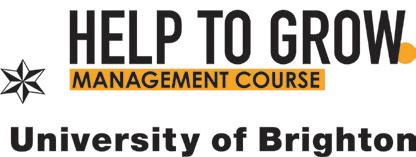




On September 8th 2025, the Bar Council published an independent review by Baroness Harriet Harman KC into bullying, harassment and sexual misconduct at the Bar. The report is forthright in its findings and calls for far-reaching reforms. Harman describes it as “a moment of reckoning for the Bar,” a sentiment echoed across the profession.
The review draws on submissions from barristers, pupils, chambers staff and other stakeholders; it also uses data from the Bar Council’s “Barristers’ Working Lives” survey and reports to Talk to Spot, the Bar Council’s confidential reporting tool. It confirms that bullying and harassment are widespread, and that the systems meant to deal with them are failing.
“Harman is blunt: ‘The problem is the culture of impunity for those at the top who commit misconduct.’”
In the 2023 survey, 44% of respondents reported experiencing or observing bullying, harassment or discrimination in the preceding two years, up from 38% in 2021 and 31% in 2017. Complaints often involve senior figures, including judges and senior barristers. Accounts describe behaviour ranging from shouted criticism in court and humiliation behind the scenes to unsolicited sexual advances at social events. One woman reported that in her first week of pupillage, a clerk demanded she sleep with him.
Many respondents expressed deep distrust in the complaints process, fearing they would be labelled troublemakers or suffer damage to their careers. Sanctions in judicial misconduct cases were often seen as lenient and lacking independent oversight.
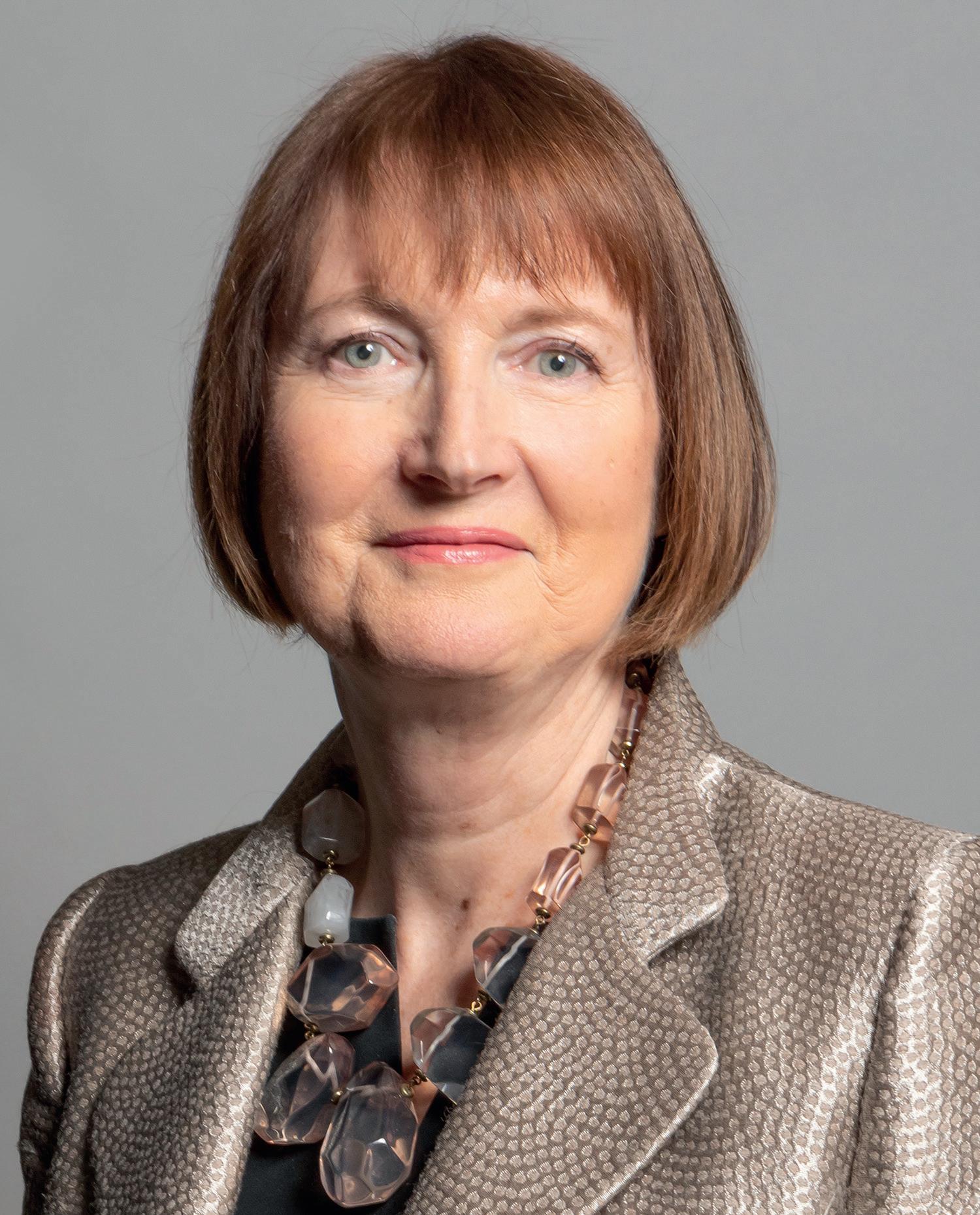
Harman is blunt: “The problem is the culture of impunity for those at the top who commit misconduct. Those in powerful positions, whether at the Bar or in the judiciary, who choose to engage in bullying, harassment or sexual harassment can be pretty confident that nothing will be done about it.”
The review contains 36 recommendations. Among the most significant:
• Mandatory anti-bullying and anti-harassment policies and training across all chambers.
• A new Commissioner for Conduct to oversee bullying, harassment and sexual misconduct cases.
• An overhaul of complaints handling, including clear time limits, improved transparency, support for complainants and consistent guidance.
• Treating sexual relations between barristers (or chambers employees) and pupils, mini-pupils or work-experience persons as serious misconduct.
• Measures to tackle judicial bullying, including enabling complaints via confidential reporting tools, adjusting time limits for investigations, court monitoring, providing audio recordings for professional users, and ensuring independent oversight in sanction decisions.
• Consideration of previous misconduct when appointing silks or judges, and prohibiting the use of non-disclosure agreements to cover up bullying or harassment.

The report has drawn strong responses. The Bar Council described it as “a once-in-a-generation opportunity for the Bar to change its culture” and committed to working with the judiciary to bring change. The Lady Chief Justice acknowledged there are “too many examples of judicial bullying” while noting that most judges behave professionally and courteously. She affirmed that the judiciary is reviewing formal and informal routes for raising concerns and improving training, resources and leadership expectations.
Some members of the profession caution that robust criticism in court could be mischaracterised as bullying if boundaries are not clear, and others warn that entrenched hierarchies may resist change. The Criminal Bar Association welcomed the report but emphasised that its proposals are the start of a long journey, particularly for criminal practitioners facing high workloads and stress.
The Bar Council has promised an action plan in the autumn. The real test is whether chambers, barristers and the judiciary will implement the recommendations consistently. Success depends on several factors:
• Cultural change: Senior judges and heads of chambers must lead by example.
• Accountability: Complaints must be handled swiftly and fairly, with meaningful consequences for misconduct.
• Support: Complainants need confidential advice, protection from retaliation and clear updates on progress.
• Monitoring: Surveys, audits and independent oversight will be vital to measure progress.
“The Bar Council has promised an action plan. The real test is whether chambers, barristers and the judiciary will implement the recommendations consistently.”
The Jo Sidhu KC case, in which the former Chair of the Criminal Bar Association was disbarred for sexual misconduct, looms large as an example of how misconduct can persist for years and how complainants often face difficult choices when coming forward.
• Judicial cooperation: Because many complaints involve the judiciary, effective reform requires collaboration across the Bench and Bar.
The Harman review is ambitious and unflinching. Its findings expose systemic failings and demand structural reform, not superficial changes. If the Bar fails to act, its reputation, morale and ability to attract new talent could suffer. The coming months will show whether the profession seizes this moment to create a healthier, fairer Bar or allows the report to become another well-intentioned document gathering dust.


Confidence is often spoken about as a personal trait, but in today’s workplace it is increasingly seen as a professional advantage. Employers recognise that a confident employee adapts more quickly, collaborates more effectively, and is more resilient. Yet, new research suggests that many young people never get the chance to develop that confidence before entering the workplace.
A recent study by social research agency Hark reveals that by Year 9, one in ten children already feels a complete lack of confidence in their ability to build a future career. At the same time, Gen Z employees are entering the workforce and struggling with resilience, workplace pressures and wellbeing. Together, these findings paint a worrying picture of a talent pipeline that is faltering before it has properly begun.
As Ben Wright, Global Head of Partnerships at Instant Offices, explains, “Confidence is not just a personal quality, it’s a business asset. The earlier we invest in building it, the stronger the workforce we create - for our companies, our communities and our economies.”
By the age of 13, many young people are already narrowing their ambitions. Some people write off careers they are interested in because they do not believe they would be capable of achieving thema. Others are unsure of the pathways available or lack role models to show what is possible. Th is is not only a personal setback but a systemic issue with long-term consequences for businesses and the wider economy.
Studies show that when students have regular opportunities to engage with employers, their aspirations rise, their attainment improves and their chances of securing employment later in life increase. Yet many schools lack the resources to provide consistent career-related learning, meaning young people miss out on the encouragement that might help them believe in their potential.
The World Economic Forum has warned of a widening global skills gap, estimating that over half of all employees will need reskilling by 2030. Alongside technical skills, soft skills such as confidence and adaptability are among the most in demand. The challenge is that too

many young people are entering the workplace without these essential qualities.
The consequences become visible once young people transition into work. Gen Z employees are praised for being ambitious, creative and socially aware, yet many also report higher levels of anxiety and uncertainty than previous generations.
“By Year 9, one in ten children feels a complete lack of confidence in their ability to build a future career.”
Forbes has described a pattern in which employers see strong energy and innovation from young staff, but also a lack of resilience and a tendency to struggle under pressure. For some, this results in early burnout or disengagement. For businesses, the costs are real: higher turnover, reduced productivity and lost potential.
“Businesses tell us they’re seeing incredible creativity




from young employees, but also higher burnout,” says Ben Wright. “The missing piece is confidence. When that’s nurtured early, we see people adapt faster, collaborate better and stay longer.”
For employers, waiting until a young person’s fi rst day on the job is far too late to begin building confidence. The earlier the intervention, the greater the impact. By engaging with schools and communities, businesses can help young people develop self-belief, understand career pathways and begin to see themselves as future professionals.
Practical initiatives can include:
different industries and roles.
• Apprenticeships and internships that allow young people to develop skills and gain confidence in real working environments.
• Partnerships with schools and charities to deliver workshops, interview training and career guidance.
The benefits are clear. Companies that adopt this approach create stronger talent pipelines, reduce early attrition, and establish a reputation as purpose-driven employers. They also play a crucial role in closing the soft skills gap that is now widely recognised as a barrier to productivity.
Some of the UK’s most resilient organisations are already leading the way by integrating confidence-building into their outreach programmes. Whether through career workshops, mentorship or volunteering schemes, they are helping young people feel prepared for the workplace. The results include wider candidate pools, improved uptake of apprenticeships and, most importantly, young people entering employment with a belief in themselves.
Employers who make confidence part of their attraction and retention strategy gain more engaged, motivated and loyal teams. As competition for talent intensifies, this will increasingly become a differentiator between businesses that thrive and those that struggle.
The future of work will not be shaped solely by technology. It will be shaped by people and their ability to believe in themselves, adapt and thrive in an unpredictable environment. Confidence is not a luxury add-on to technical skills. It is the foundation that allows those skills to be used effectively.
“Confidence is not a luxury add-on to technical skills. It is the foundation that allows those skills to be used effectively.”
• Mentorship programmes where employees volunteer to support pupils, answer questions and share their own career journeys.
• Workplace visits that give students fi rst-hand exposure to
For today’s young people, the confidence gap begins as early as secondary school. For employers, the costs are felt in disengagement and high turnover. The solution is for businesses to take a more proactive role in building career confidence long before job applications are submitted. Supporting young people in building belief in themselves today is one of the most important investments employers can make in securing the resilience of tomorrow’s workforce.
“While menstrual migraines can feel daunting, there are more treatment choices than ever.”
By Jasmin Jetchev BSc (Hons)

For many, migraines are an all too familiar disruption. But when these attacks arrive like clockwork with the menstrual cycle, the impact can feel relentless. Menstrual migraines are not just “bad headaches”. They are longer lasting, harder to treat, and often more severe than other migraine types.
Menstrual migraines usually strike between two days before and three days after a period begins. The pain is pulsating, often one-sided and comes with nausea, vomiting and a deep sensitivity to light or sound. Some people also experience an aura, characterised by temporary neurological symptoms such as visual changes, before the pain arrives.
Two forms are recognised. Pure menstrual migraines happen only in the perimenstrual window, while menstrually related migraines occur during that time and at other points in the cycle. Around 17% of people with migraine are affected, so if this pattern sounds familiar, you are not alone.
The leading explanation is hormonal. Just before menstruation, oestrogen levels drop sharply. That fall appears to trigger the trigeminal nerve, a major pathway for migraine pain, and may also lower serotonin, a brain chemical that normally offers some protection against attacks. This theory is reinforced by what happens in pregnancy, when high, stable oestrogen levels often stop migraines. In contrast, the hormone swings of perimenopause can make migraines worse, while after menopause, they usually calm down.
(Ajovy), galcanezumab (Emgality) and rimegepant (Vydura) are now options for prevention.
If menstrual migraines are frequent, disabling or unresponsive to acute therapy, a preventive approach may be worth considering. For those with predictable cycles, short-term prevention can work well. This means starting medication a day or two before the period and continuing for around five days. Options include taking naproxen at a higher dose or a triptan, such as frovatriptan or zolmitriptan, during that window.
For others, longer-term strategies may be needed. Hormonal methods that maintain steady oestrogen levels, such as continuous use of the combined contraceptive pill, patch or vaginal ring, can reduce attacks. However, these are unsuitable for anyone who experiences migraine with aura due to increased stroke risk. In such cases, nonhormonal preventives like topiramate or CGRP blockers may be considered instead.
“Around 17% of people with migraine are affected, so if this pattern sounds familiar, you are not alone.”
Medication is only part of the picture. Many find that lifestyle adjustments ease the overall burden. Aim for regular balanced meals, steady hydration, consistent sleep and exercise three to five times a week. Stress management techniques, such as mindfulness, breathing practices, and gentle yoga, can help keep attacks at bay.
When a menstrual migraine strikes, the best response is early action. Retreating to a dark, quiet room and taking medication as soon as symptoms begin is known to make a real difference. Cooling your head or neck with a cloth, sipping water to stay hydrated and gentle stretching have all been reported to help ease discomfort.
Over-the-counter painkillers such as ibuprofen or paracetamol may help milder episodes. For many, though, these migraines demand something stronger. Triptans are the mainstay in the UK, with options including rizatriptan (Maxalt), sumatriptan (Imigran), and zolmitriptan (Zomig). These medicines are available as tablets, nasal sprays or injections, depending on what works best for you. If nausea is a major issue, doctors may add an anti-sickness drug like metoclopramide or prochlorperazine.
Some newer drugs seen in America, like lasmiditan or ubrogepant, are not licensed in the UK. But alternatives are available here. Alongside triptans, treatments such as the CGRP blockers erenumab (Aimovig), fremanezumab
Keeping a diary can be useful. By noting the timing of headaches, as well as factors such as food, stress, and sleep patterns, it becomes easier to spot and avoid personal triggers. Even small changes can reduce the number and intensity of attacks.
Menstrual migraines are not just painful - they can derail daily life. The stress of missed commitments may then fuel a cycle of anxiety and guilt. Talking openly with your GP or a headache specialist about how migraines affect you is essential. Together, you can build a treatment plan that covers both the physical and emotional toll.
There is also a noted overlap with premenstrual dysphoric disorder (PMDD), a severe form of PMS marked by overwhelming mood changes. If you recognise both sets of symptoms, raise this with your healthcare provider as it may influence your treatment approach.
While menstrual migraines can feel daunting, there are more treatment choices than ever. With the right plan in place, you can move from feeling at the mercy of your cycle to having control again.
“Creatine is one of the researched supplements For healthy adults, it is considered very safe at recommended

the most available. considered recommended doses.”

By Jasmin Jetchev BSc (Hons)
Mention creatine, and most people still think of gym powders and bodybuilders. Yet research shows this naturally produced compound may be just as valuable for women across all stages of life. From fuelling workouts in your 20s to supporting muscle, bone and even cognitive health later on, creatine could be one of the most useful and underappreciated supplements.
Creatine is made in your body and stored mainly in muscle. Its job is to recycle ATP, the energy currency that powers quick bursts of effort. Think sprinting, lifting weights or simply climbing stairs in a hurry. Beyond energy, it may protect cells and support brain function, with hundreds of studies highlighting its broad safety and benefits.
You also get creatine from food. Red meat and fish provide the most, but a standard portion delivers less than a gram. Since experts suggest a daily intake of around two to four grams depending on activity levels, diet alone may not be sufficient. If you follow a vegetarian or plant-based diet, supplementation becomes almost essential.
In your 20s and 30s
These are the decades of performance. If you train regularly, creatine can help boost strength, power and lean muscle while improving recovery between demanding sessions. Women who lift weights or enjoy HIIT often notice more stamina and faster progress when supplementing.
In your 40s and 50s
This is when gradual muscle decline can begin. Adding creatine here is less about chasing personal bests and more about maintaining what you have. Combined with resistance training, it can help preserve lean mass, strength and function. That translates into more energy at work and across the board. Some research even suggests benefits for bone health, making it ideal for women at midlife.
DURING AND AFTER MENOPAUSE
Hormonal shifts can accelerate muscle and bone loss. Creatine at this stage has been linked with improvements in muscle quality and may work well with strength exercise to reduce the risk of frailty. Early studies also point to potential mood and energy benefits, though more data is needed. For many women, this is the stage where supplementation feels most protective.
In older age creatine may still support muscle and functional strength, but its appeal extends to the brain. Trials suggest potential gains in short-term memory, processing speed and resilience under stress. While claims of guaranteed cognitive improvement are premature, creatine appears to offer gentle support for both body and mind.
A daily dose of two to four grams of creatine monohydrate is sufficient for most women. Some people use a “loading phase” of higher amounts for a week, but this is not necessary. Consistency matters more than timing, take it with breakfast, after training or whenever it fits your routine.
Creatine is one of the most researched supplements available. For healthy adults, it is considered very safe at recommended doses. The main side effects reported are mild water retention or occasional stomach upset. If you have kidney problems, take medication affecting kidney function, are pregnant or breastfeeding, check with your GP first.
Choose a high-quality creatine monohydrate from a reputable brand, ideally third-party tested. Creatine is not a magic powder, but it is a simple, well-studied, and affordable supplement. Together with strength training, good food and enough sleep, it can be a quiet ally in keeping you strong, capable and confident at every stage of life.
By Kellie Miller Harbour

Helen Nottage’s sculptures pay homage to anatomy, one of the oldest scientific disciplines. Anatomy has undergone an evolution from its infancy in the 3rd Century, with its subsequent development marked by the introduction of Anatomical Theatres, when dissection became a performance art.
Honoré Fragonard, in the 18th Century, even rendered his specimens into artefacts. Anatomical artists proceeded to create whole-body examples, which were dried and vanished. They wanted to preserve their specimens to document and display artistically so that the pieces would last.
More recently, the first ‘Body Worlds’ exhibition was held in Tokyo, Japan, in 1995. It showcased plastination-preserved human bodies, a process developed by Dr Gunther von Hagens. The purpose of the show was to educate the public about the inner workings of our bodies and highlight the damaging effects of lifestyle choices like drinking and smoking.
When Helen Nottage saw the ‘Body Worlds’ exhibition in London in 2002, it had a profound impact on her. Helen says, “I loved the way he isolated certain structures through plastination. The network of veins and capillaries in the hand, and how similar the structures looked to tree branches or coral.”
“When Helen Nottage saw the ‘Body Worlds’ exhibition in London in 2002, it had a profound impact on her.”

At the same time, Helen embarked on a life-affirming project at university, where her love of gardens, mythology and the body collided. The project involved designing an item for an outdoor space. Choosing to produce a sculpture, she harked back to her childhood fascination with the illustrated books by Arthur Rackham.
Rackham’s success peaked during the Golden Age of British book illustration, from 1890 to 1918. He challenged the viewer by presenting images that were both reassuring and frightening. It was his artworks that were to plant the seeds of inspiration in Helen’s sculptures today.
What she found in the ‘Body Worlds’ exhibition was that everything fitted together amazingly, the way all these different organs had developed in various ways from a tiny cluster of cells to form such a complex organism, and being able to see into all the layers which had been peeled away. An awe-inspiring hidden world inside the body. While her ideas were also fitting together simultaneously, some from many years ago all converged at the same space and time— an eureka moment.

“Helen’s figurative, écorché sculptures are layered with imagery from nature ”
Helen’s figurative, écorché sculptures are layered with imagery from nature. Combined with the notion of decay, they reflect the temporary nature of life and the fragility of existence. Yet she chooses to capture her works in clay. Clay, which derives from earth, the place where we all will eventually return to and be recycled. Ceramics, fired clay, need all of the elements to come into being and will outlive us—it doesn’t decay. Like those early anatomists wanting to preserve their creations, Helen is doing the same with her ideas, embedding them in clay for perpetuity.
Kellie Miller is an artist, curator, critic and gallery owner.
Kellie Miller Arts, 3 Church Street, Brighton, BN1 1UJ Brighton. kelliemillerarts.com Strata
For many aspiring writers, self-publishing holds the promise of bypassing gatekeepers and retaining a greater share of revenues. But the path is littered with risk and uncertainty. For an unknown author, is it really financially viable? The short answer: yes, in some cases, but it is the exception rather than the rule.
A survey by the Alliance of Independent Authors showed that in 2022, the median income from self-publishing among serious indie authors (authors who self-publish) was about £10,000, while the average was over £65,000. The gap reflects a few big successes that have lifted the mean. Nearly a quarter of respondents earned less than £800. By contrast, authors using traditional publishing models had a median income of around £7,000, suggesting that successful indie authors may outperform many traditionally published peers. But this masks a “winner-takes-all” structure: the top 1% of indie authors earned nearly a third of all reported revenues.
Other surveys confirm that earnings remain skewed. Close to half of self-publishing writers earned £80 or less per month from their books. Only about one in six reported mid-tier monthly earnings between £200 and £800, while another one in six earned significantly more.
Traditional publishing outcomes are also difficult. In the UK, the median author income has been estimated at around £7,000 per year, which is well below the level required for a living wage. The numbers suggest that while a few self-publishers make substantial income, sadly, most do not recoup their time or investment.
WRITING IS ONLY THE START
To understand viability, authors need to break down both revenues and costs:
Revenue side
• Self-published authors selling eBooks often receive 35% to 70% of the retail price, depending on the platform.
• For example, a £7.99 eBook could bring the author £5.50 if they receive 70%. A paperback sold for £10 might net about £4 to £5 after printing and distribution.
• By comparison, traditional publishing royalties typically range from 10% to 15% of the cover price, and only after the advance has been earned out.
Therefore, the revenue per unit is higher in self-publishing, but only if a sufficient number of units are sold.
Cost side
Authors need to invest upfront in:
• Editing and proofing
• Cover design and formatting
• ISBNs and related publishing costs
• Marketing and promotion (ads, giveaways, review services)
• Distribution and, for physical runs, storage and shipping
• Their own time, which is the largest hidden cost
Producing a professional book can cost anywhere from £500 to £3,000, depending on the services required. Only rarely does marketing pay off enough to recoup that immediately.
Several factors greatly affect whether an unknown author will turn a profit:

• Genre: Romance, crime, thrillers and fantasy tend to perform best in the indie space because of established readerships.
• Author expertise or platform: In nonfiction, authors with authority in business, health or self-help often find it easier to market.
• Backlist and volume: Many successful indie authors publish ten or more books, building a cumulative income stream.
• Marketing sophistication: The effective use of mailing lists, digital ads, and pricing strategies often separates successes from failures.

• Geographic reach: Global digital distribution multiplies the potential audience.
• Alternative revenue models: Audiobooks, speaking events and courses can turn a modest book into a wider income source.
Some British authors demonstrate what is possible at scale. Adam Croft, a thriller writer, has reported sales exceeding £1 million across multiple titles. R.R. Haywood, another self-published author, has sold millions of copies across various genres. These outliers demonstrate that the model can be effective.
A mid-spectrum scenario sees an author launching a niche nonfiction guide priced at £9.99 in eBook format. If she nets about £6 per copy and sells 1,000 copies in a year, she makes £6,000. Subtract £2,000 spent on editing, design and advertising, and she clears £4,000. This is a modest side income. To achieve a sustainable full-time income of £25,000 or more, she would need to develop multiple books, strengthen her marketing, or establish additional revenue streams, such as online courses.
“The numbers suggest that while a few self-publishers make substantial income, sadly, most do not recoup their time or investment.”
Many self-published books, however, sell fewer than 100 copies in their lifetime. Clearly the hours spent writing, editing and promoting often outweigh the financial return.
Self-publishing can be financially viable in limited circumstances, especially when the author treats it as a business, publishes multiple titles, invests in quality and understands marketing.
• Do market research to understand your target demographic
• Start small with one book in a clear niche to test demand.
• Invest in professional editing and design to avoid bad reviews.
• Build an author platform before launch.
• Focus on marketing skills as much as writing.
• Think long term, with a strategy for multiple titles rather than relying on a single “hit.”
Be prepared to be patient and persistent!












By Tess de Klerk




I’ve long wanted to visit the island named after Icarus, the mythological figure who flew too close to the sun, his wax and feather wings melting as he fell. It’s a warning against human hubris, yes, but Ikaria itself is anything but tragic. It is one of the world’s famous Blue Zones, where people live long, healthy lives, often well into their nineties and beyond.
My friend and I decided to move around the island rather than stay in one place. She, luckily, is Greek and has a gift for making people feel at ease. And I love getting to know
people in the places I travel to, hearing their views and stories. It was ideal.
Th is remote Aegean island is greener than most, with plenty of water by Mediterranean standards and forests climbing up its rugged mountains. In fact, it is no surprise that one of the reasons for the islanders’ longevity is that they used to walk mountain roads from village to village. What was surprising was that many people still do. In fact, we did a few times as it seemed like less hassle than driving the windy, narrow roads. Walking up and down steep









By Tess de Klerk


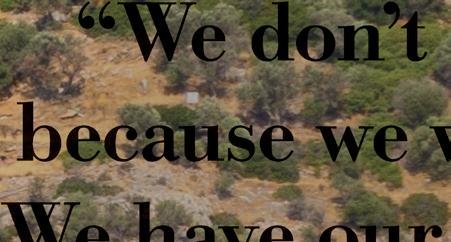


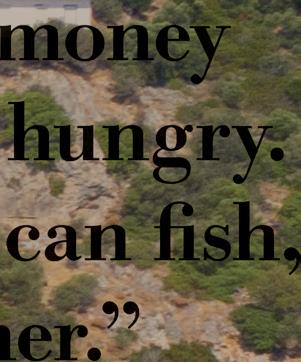
“We don’t stress about money because we will never go hungry. We have our gardens, we can fi sh, and we have each other.”
mountain paths is just a way of life there and feels like the natural thing to do.
The Ikarians know how to celebrate. Their famous panagiria, festivals honouring saints (and there are plenty of them), bring communities together for music, dancing and wine until dawn. Enjoying life is not a luxury here; it’s considered non-negotiable nourishment for the soul. Wine is an essential part of that enjoyment, believed not only to gladden the heart but also to support health, taken daily and in moderation.



We stayed in two mountain villages and also in Therma, a seaside settlement named for its thermal springs. The main spring in Therma bubbles up from the seabed, having flowed through radioactive rock formations that contain high amounts of radium and radon. It is said that the natural radioactivity of the water aids longevity and can treat many ailments, including arthritis and skin diseases.
“It is one of the world’s famous Blue Zones, where people live long, healthy lives, often well into their nineties and beyond.”
You’ll find many springs across the south side of the island, but we particularly enjoyed the spring in an open sea cave in Therma – the hot waters and cold seawater mixing in a most invigorating way. While in Therma, we stayed in the tranquil Agrioglycos Pension perched on a cliff overlooking the tiny village. It really was an exceptional place. Simple rooms, but the most perfect grounds for a quiet, lazy and stunningly beautiful stay.

If you go, book a hike with Lefteris of Ikarian Footsteps. His family has lived there for generations, and his knowledge of the island’s nature, history and traditions runs deep. He explained how Ikaria’s steep terrain once shaped a society of equals.
Each family could only cultivate what their land allowed, which kept livestock and produce in balance. There was no great wealth divide because no one could own much more than they could manage. People traded, shared, and to a large extent still do. Ikaria is not the island for luxury resorts or flashy hotels. As our taxi driver, Lazarus, told me, “We don’t stress about money because we will never go hungry. We have our gardens, we can fish, and we have each other.”
That attitude lies at the heart of Ikarian longevity. People don’t hurry. They don’t obsess about stress or wealth. A local baker put it perfectly when he said, “It can be difficult to deal with the stress and urgency visitors bring, but we understand. A few days here is not enough to adopt our way of life.”
One evening, we visited Mehdi, an Iranian who has built a rustic sanctuary on the slopes of a ravine, a place where travellers gather to immerse themselves in music, colour and nature. His partner is a striking Ikarian woman who grew up in New York but spent every summer of her childhood on the island, returning still whenever she could. She explained that there is a very strong Ikarian community in the United States, especially in New York, where they meet regularly to decide how best to support their island.


It was the diaspora who funded Ikaria’s hospital, now home to excellent doctors, including a respected orthopaedic surgeon. She spoke with such pride about how the expat community, though far away, still feels deeply tied to the island and how many of them eventually come back to spend their later years there. Listening to her, I realised Ikaria’s strength lies not only in those who never left but also in those who carry its spirit across oceans and then bring it back again.
Ikaria is mostly mountainous, so its beaches are fewer than on other Greek islands, which spares it from mass tourism. My favourite was Nas, with the ruins of a temple to Artemis gazing over the shore. It takes effort to reach, down long steps past a river. The sea around Ikaria can be dangerous, with unpredictable currents and winds, so this isn’t a destination for those who only want to swim and sunbathe. The island is about exploring, learning and integrating.
Our next stay was in Raches, the island’s main mountain village. It’s full of traditional cafeneios where people gather

Ikaria is remote and can be reached by overnight ferry from Athens or flights from Athens and Thessaloniki.
There are weekly flights from Gatwick via Athens to Ikaria
for drinks and chatter, bars and plenty of small tavernas. Little shops cater to every need, and I especially loved the women’s co-op, which sold everything from baked goods to homemade wine, all excellent and affordable. What struck me most was the welcome.
This wasn’t only in Raches but everywhere on the island. Hospitality is a way of life here, rooted in open-hearted generosity and the belief that community matters more than wealth. Islanders have long opened their homes to visitors, offering food, drink and shelter even when resources were scarce. That spirit is still alive today. Hospitality here is not a transaction; it’s a way of being.
My time on Ikaria was a much-needed reset. To be reminded that there are places in the world where stress is a stranger has left me with the ability to breathe deeply and let go in the face of anxiety. Blue Zone lesson learnt.

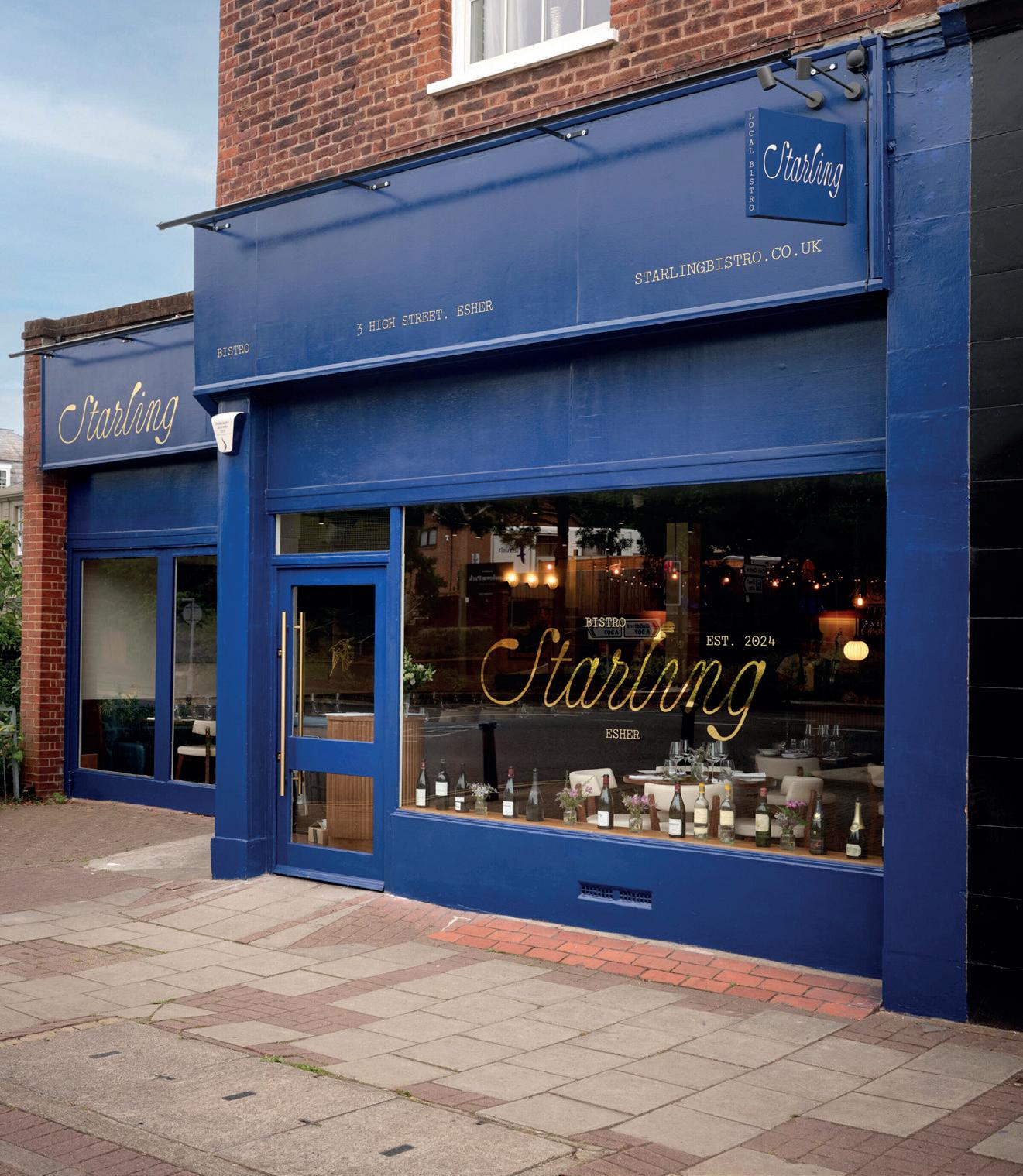
By Charlin Thompson
Nick Beardshaw has spent years at the top end of British cooking. After training and working alongside Tom Kerridge, most recently running Kerridge’s Bar & Grill in London, he took the plunge in 2024 and opened his own place. Starling Bistro arrived on Esher High Street in August of that year, promising seasonal British food with a bistro feel. Within just a few months, it was awarded a Michelin star, which tells you how quickly it has struck a chord.
We booked as a table of four, and straight away it felt like somewhere you could settle in for the evening. The room has a relaxed confidence: smart without being stiff, stylish without being intimidating. Service was smooth and friendly. The drinks list deserves a mention too, with a smart range of wines and a cocktail selection that hits the sweet spot between creative and easy-to-drink.
Our first plates were a good sign. The truffle cheese crumpets were soft and comforting with a gentle punch of truffle that never got too much. The hand-dived Orkney scallops with artichoke, maple, and bacon were perfectly cooked and full of sweetness, with the bacon and maple bringing smoky and sweet notes that lifted the dish.
We couldn’t resist trying the honey-glazed chicken nugget with buffalo sauce. This was worlds apart from anything you’d find in a takeaway box: golden, crisp, sticky, and spicy in just the right measure. The prawn scotch egg was another favourite, delicately balanced and light, with the prawn filling keeping everything fresh and clean rather than heavy.
For the main course, we ordered the sirloin steak for two, served with a bowl of chips that might just be the best around. The steak had real depth of flavour, was cooked exactly as ordered, and was properly rested. The chips were golden, crunchy, and fluffy inside - simple but flawless.
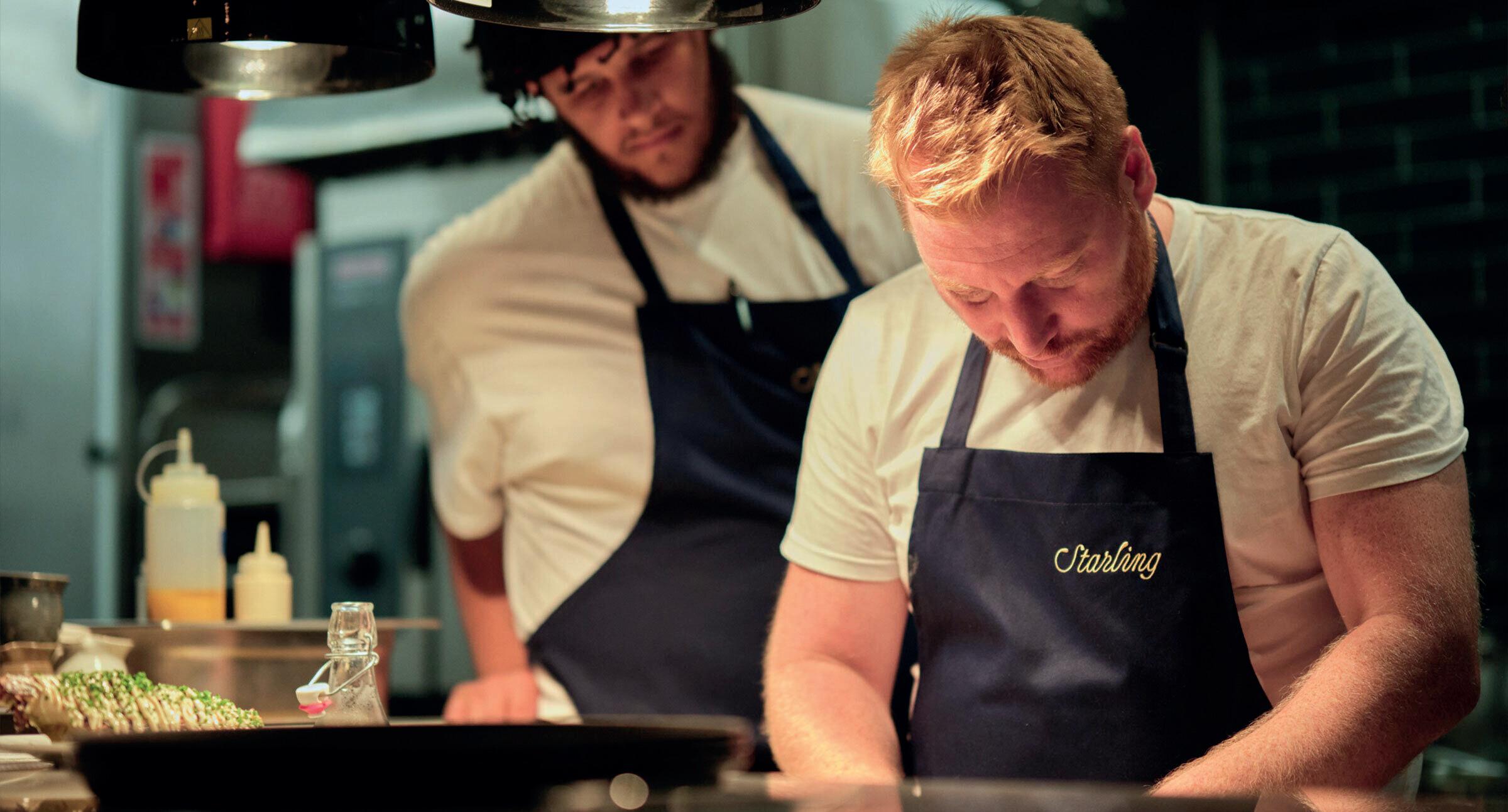
The Cornish jumbo plaice came with grilled courgettes, a langoustine bisque, and Thai basil. It was elegant and well-judged; the bisque provided richness, while the basil added freshness. The pork tenderloin was tender and nicely cooked, though one of our group felt the seasoning had tipped slightly too far on the salty side.
We decided to share a single dessert: Beardshaw’s “Balloon Girl.” This is the raspberry cheesecake that he created for Great British Menu in 2023, and it really delivered. Sharp raspberry, creamy cheesecake, and a little chocolate detail came together in a dish that was playful, beautiful, and satisfying to eat.
courses for £30. We didn’t try it this time, but it’s firmly on the list for our next visit.
“This is the sort of restaurant you book for a special night out, and Esher is lucky to have it.”
Starling Bistro feels like a confident debut from a chef who has taken everything he learned in big kitchens and poured it into a place with character. The food is thoughtful without being overcomplicated, and the atmosphere makes it somewhere you actually want to linger. For us, the highlights were the scallops, the prawn scotch egg, the steak with those incredible chips, and the “Balloon Girl” dessert.
Nobody books a Michelin-starred restaurant expecting bargain prices, but we didn’t feel the cost was unreasonable given the quality of the food and the standard of service. For those looking for a more affordable way in, Starling also runs a set lunch on Wednesdays and Thursdays: three

As you’d expect from a Michelin-starred spot, it isn’t cheap, but it never felt out of line with the quality of the evening. This is the sort of restaurant you book for a special night out, and Esher is lucky to have it. We left, already planning our return. Highly recommended.
££
3 High St, Esher KT10 9RL www.starlingbistro.co.uk


By Fiona Shafer, Managing Director of MDHUB
“The future is electric Fi and you had better get used to it” said Maarten back in March 2020 as he gleefully handed over the keys to my very first electric car experience with the Audi E-Tron Quattro.
Fast forward to September 2025 and several electric car rants down the line, Maarten asked me to write about what I really think about his early prediction. No surprise it is THE question that both of us get asked more than most about the cars we review.
I have covered a veritable smorgasboard of EVs during this time: the Audi e-tron; Jaguar F-Pace; Fiat 500e (ah, we won’t ever forget that amusing little drama of putting the key in the central console and wiping out the battery!); Fiat Arbath; VW ID.5 and, very recently, the new Honda e:NY1 …with the occasional passenger ride in a Tesla along the way.
The second is the driver who lives a “purposely, unhurried lifestyle” but wants an instant response to everything including car charging, thinks buying an electric car is ”the right thing to do,“ is possibly a secret status symbol to tell their friends about and apparently saves money (although they have not really bothered with the calculations) and is good for popping around town.
To get the best out of an electric car experience, I recommend that you repurpose the current three-word Government dictat of the need to research, research and research.
Consider the type of car, its range, your journey planning, charging stations and if it is worth the not inconsiderable
“Research reveals that most drivers in favour of swap stations say it is because it would save them time”
I could share a long list of my thoughts on the pros and cons of buying an EV, alongside the growing tide of media hype - good and bad - about them and the impact on our environment (or not), but have concluded that if you decide to buy one, it really does come down to the type of driver you are.
I have observed that in the main, the people who have decided to buy electric cars currently fall into two camps, to which I will add a rider that I take my hat off to you all for embracing these new technologies and new way of driving for the rest of us.
First up – the highly curious driver who is loves technology, engineering and the environment, is an expert logistics planner and loves the cost savings it can bring, often smugly and joyously declaring upon arrival at a destination, “well, that cost us absolutely nothing!” – which in the event of doing so, I think there should be a Cavalry Charge Bugle call programmed into all EVs – rather like the RyanAir Landings…?

investment. You also need to factor in time for unplanned events, chargers that are not working (even those installed at home), traffic holdups, and an EV literally dying on you with no warning, as well as the recent lack of spares to fix them. These are the key factors where things can go horribly wrong with EVs. Talking with a specialist technical car insurer recently, they are now seeing an increasing number of challenging and complex EV claims landing on their desks – so be warned.
“My absolute rule of thumb for car buying – no matter what make, buy a car that makes you smile every time you drive it.”
In August 2025, the UK Government made a substantial announcement about a £650 million Electric Car Grant (ECG) programme, which includes discounts of up to

£3,750 on cars priced under £37,000 – these can be claimed directly from dealerships. The programme will run until 2028/2029 and also includes discounts of up to £1,500 for other car models that do not quite meet the required eco standards. The discount will be automatically applied to the purchase of the vehicle and customers do not need to complete any paperwork.
At the moment, about 50 electric models will qualify, apparently making the whole market a lot more affordable, so it is worth investigating. What would make it even more affordable is if the grant contributed towards a home charger, not just the kerbside points.
But will these incentives really be enough to convert the seriously cost-conscious and environmentally-conscious folk? We know that one of the key downsides of electric cars is their use of rare metals, and manufacturing electric vehicles generates more emissions, and they are only as green as their power sources.
Looking ahead, despite significant Government investment into the UK EV charging network, new research suggests that 73% of drivers would support battery swap stations, where an EV’s depleted battery could be swapped for a fully charged one in just five minutes.
Research by Venson Automotive Solutions reveals that most drivers in favour of swap stations say it is because it would save them time, indicating many motorists consider even a 20-minute ultra-rapid charge to be too long. 17% of motorists oppose battery switching, saying it sounds expensive, is not environmentally friendly or sounds dangerous.
My final word on this, and it is personal. I almost considered buying an EV this summer after a very stressful and troublesome period with my British-made diesel car (a reliable but not particularly loved) workhorse of eight years, for practical reasons. However, in the end, I decided to sell it. I returned to a 17-year-old petrol car in amazing condition with just 51,000 miles on the clock and outstanding sustainability.
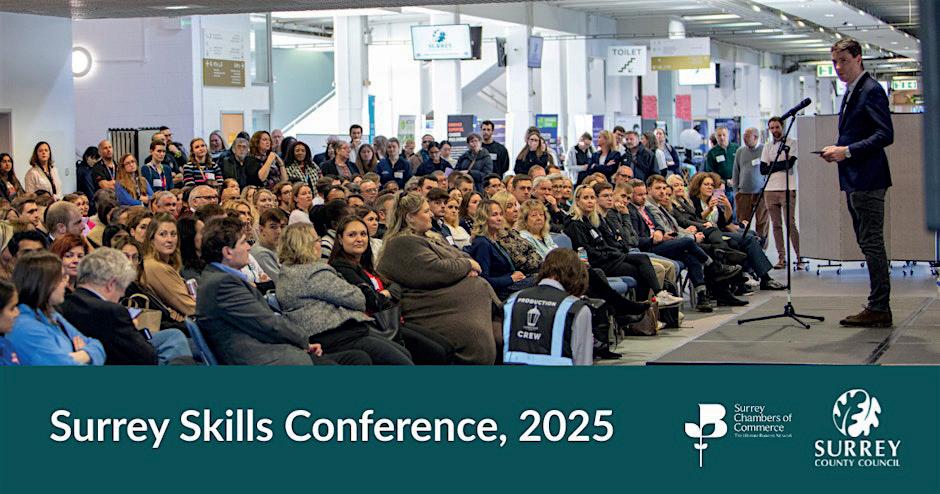
WOKING
SURREY SKILLS CONFERENCE 2025
A one-day event with talks, workshops and panels about skills, employment, education policy. Brings together business leaders, educators and decision makers to explore workforce trends and how to equip people for future jobs.
Hilton Woking October 17th www.eventbrite.co.uk/e/ surrey-skills-conference-tickets-1558963043429
BRIGHTON BRIGHTON BUSINESS EXPO
A regional business expo with dozens of exhibitors, free seminars and workshops, speed networking, showcase of services, aimed at entrepreneurs, SMEs and professionals wanting to expand networks and get business ideas.
Brighton Racecourse October 23rd, 10:00-14:00 www.b2bexpos.co.uk/event/brighton-expo-october-2025



TONGHAM SURREY HILLS FIRE & FOOD FAIR 2025
Live-fire cooking demos, artisan food stalls, cosy fire pits, drinks, and outdoor living exhibits over the autumn weekend.
Hogs Back Brewery, Tongham October 18th-19th https://surreyhills.org/event/ surrey-hills-fire-and-food-fair-2025/
WEYBRIDGE SIGNATURE WEDDING SHOW
A grand wedding expo gathering vendors, bridal boutiques, florists, photographers and venues under one roof. Free entry, goody bags, and a chance to enter to win a luxurious honeymoon. Great for those planning their big day.
Mercedes-Benz World, Weybridge October 12th https://www.yoursurrey.wedding/event/21938/october-2025/ signature-wedding-show-mercedes-benz-world-12102025

A large fine art fair showcasing over 90 artists, more than 3,000 works. Visitors can meet creators, browse a wide variety of styles and mediums, enjoy wine on opening night, and collect inspiring artworks in a grand racecourse setting.
Epsom Downs Racecourse
October 3rd-5th
https://www.eventbrite.com/e/art-surrey2025-at-epsom-downs-racecoursetickets-1399965918749

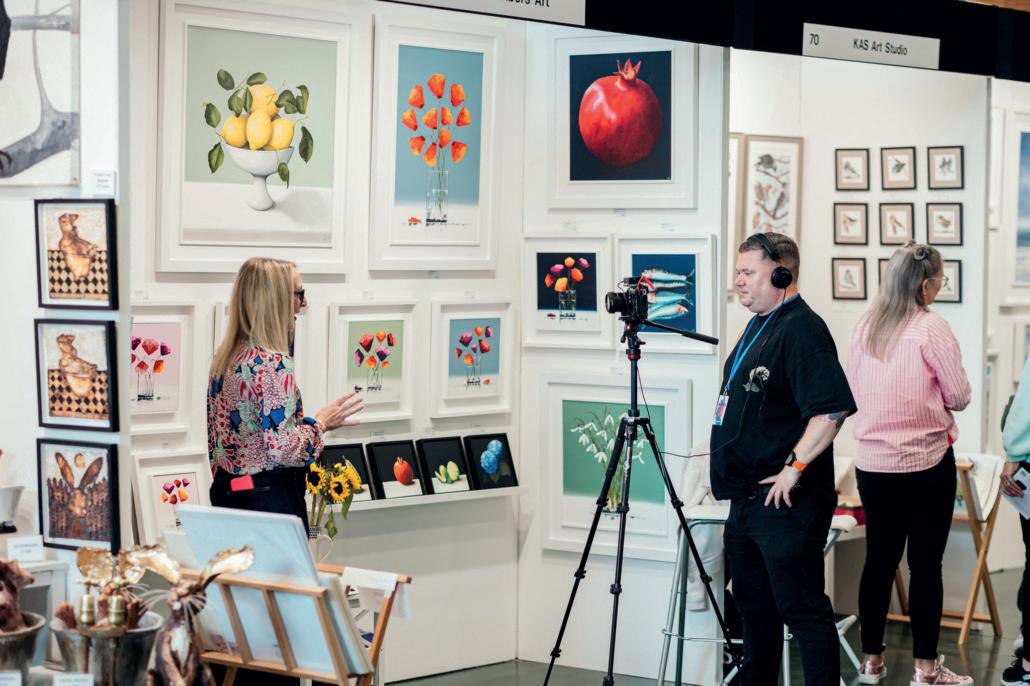
A workshop exploring portrait techniques with expert guidance—ideal for both beginners and experienced artists.
Charleston House, Firle October 14th
https://www.newexhibitions.com/gallery/2096
Featuring Seann Walsh, Zoe Lyons & Marcus Brigstocke.
A night of stand-up hosted by top UK comedians, bringing sharp jokes, social commentary and laughs.
Devonshire Park Theatre, Eastbourne October 11th
https://www.eastbournetheatres.co.uk/



A theatrical musical adaptation of the beloved book series, full of adventure, mythological monsters and catchy songs.
Theatre Royal, Brighton September 30th – October 4th
www.theatreinbrighton.co.uk/theatre-royal-brighton/musical/

